Indium Mineralization in the Volcanic Dome-Hosted Ánimas–Chocaya–Siete Suyos Polymetallic Deposit, Potosí, Bolivia
Abstract
1. Introduction
2. Geologic Setting
2.1. Geodynamic Setting
2.2. Geology of the Deposit
3. Materials and Methods
4. Mineralogy and Textures
4.1. Siete Suyos Mine
4.2. Ánimas Mine
4.3. Chocaya Mine
5. Ore Mineral Geochemistry
5.1. In-Bearing Minerals
5.2. Other Minerals
6. Discussion
6.1. Paragenetic Sequences and Evolution of the Mineralizing Fluids
6.2. Indium: Mineralogical Expression and Controls on Its Distribution
7. Conclusions
Supplementary Materials
Author Contributions
Funding
Acknowledgments
Conflicts of Interest
References
- Jorgenson, J.D.; George, M.W. Mineral Commodity Profile: Indium. U.S. Geological Survey Open-File Report 2004-1300; 2004. Available online: https://pubs.usgs.gov/of/2004/1300/2004-1300.pdf (accessed on 3 December 2018).
- Bleiwas, D.I. Byproduct mineral commodities used for the production of photovoltaic cells. US Geol. Surv. Circ. 2010, 1365, 1–10. Available online: http://pubs.usgs.gov/circ/1365 (accessed on 30 April 2019).
- Skirrow, R.G.; Huston, D.L.; Mernagh, T.P.; Thorne, J.P.; Dulfer, H.; Senior, A.B. Critical Commodities for a High-Tech World: Australia’s Potential to Supply Global Demand; Geoscience Australia: Canberra, Australia, 2013.
- Kesler, S.E.; Simon, A.C. Mineral Resources, Economics and the Environment, 2nd ed.; Cambridge University Press: Cambridge, UK, 2015; pp. 243–244. [Google Scholar]
- Sykes, J.P.; Wright, J.P.; Trench, A.; Miller, P. An assessment of the potential for transformational market growth amongst the critical metals. Appl. Earth Sci. 2016, 125, 21–56. [Google Scholar] [CrossRef]
- European Commission. Critical Raw Materials. Available online: https://ec.europa.eu/growth/sectors/raw-materials/specific-interest/critical_en (accessed on 5 July 2018).
- Frenzel, M.; Mikolajczak, C.; Reuter, M.A.; Gutzmer, J. Quantifying the relative availability of high-tech by-product metals—The cases of gallium, germanium and indium. Resour. Policy 2017, 52, 327–335. [Google Scholar] [CrossRef]
- Shanks, W.C.P., III; Kimball, B.E.; Tolcin, A.C.; Guberman, D.E. Germanium and indium. In Critical Mineral Resources of the United States—Economic and Environmental Geology and Prospects for Future Supply; Schulz, K.J., DeYoung, J.H., Jr., Seal, R.R., II, Bradley, D.C., Eds.; U.S. Geological Survey Professional Paper; U.S. Geological Survey: Reston, VA, USA, 2017; pp. 1–27. [Google Scholar] [CrossRef]
- Werner, T.T.; Mudd, G.M.; Jowitt, S.M. The world’s by-product and critical metal resources part III: A global assessment of indium. Ore Geol. Rev. 2017, 86, 939–956. [Google Scholar] [CrossRef]
- Avarmaa, K.; Klemettinen, L.; O’Brien, H.; Taskinen, P.; Jokilaakso, A. Critical metals Ga, Ge and in: Experimental evidence for smelter recovery improvements. Minerals 2019, 9, 367. [Google Scholar] [CrossRef]
- Schwarz-Schampera, U.; Herzig, P.M. Indium: Geology, Mineralogy and Economics; Springer: Heidelberg, Germany, 2002. [Google Scholar]
- Cook, N.J.; Ciobanu, C.L.; Pring, A.; Skinner, W.; Shimizu, M.; Danyushevsky, L.; Saini-Eidukat, B.; Melcher, F. Trace and minor elements sphalerite: A LA-ICPMS study. Geochim. Cosmochim. Acta 2009, 73, 4761–4791. [Google Scholar] [CrossRef]
- Cook, N.J.; Ciobanu, C.; Williams, T. The mineralogy and mineral chemistry of indium in sulphide deposits and implications for mineral processing. Hydrometallurgy 2011, 108, 226–228. [Google Scholar] [CrossRef]
- Schwarz-Schampera, U. Indium. In Critical Metals Handbook, 1st ed.; Gunn, G., Ed.; American Geophysical Union and Wiley: Chichester, UK, 2014; pp. 204–229. [Google Scholar]
- Ohta, E. Occurrence and chemistry of indium-containing minerals from the Toyoha Mina, Hokkaido, Japan. Min. Geol. 1989, 39, 355–372. [Google Scholar]
- Shimizu, T.; Morishita, Y. Petrographic, chemistry and near-infrared microthermometry of indium-bearing sphalerite from the Toyoha polymetallic deposit, Japan. Econ. Geol. 2012, 107, 723–735. [Google Scholar] [CrossRef]
- Frenzel, M.; Hirsch, T.; Gutzmer, J. Gallium, germanium, indium and other trace and minor elements in sphalerite as a function of deposit type—A meta-analysis. Ore Geol. Rev. 2016, 76, 52–78. [Google Scholar] [CrossRef]
- Bauer, M.E.; Seifert, T.; Burisch, M.; Krause, J.; Richter, N.; Gutzmer, J. Indium-bearing sulfides from the Hämmerlein skarn deposit, Erzgebirge, Germany: Evidence for late-stage diffusion of indium into sphalerite. Min. Depos. 2019, 54, 175–192. [Google Scholar] [CrossRef]
- Bauer, M.E.; Burisch, M.; Ostendorf, J.; Krause, J.; Frenzel, M.; Seifert, T.; Gutzmer, J. Trace element geochemistry of sphalerite in contrasting hydrothermal fluid systems of the Freiberg district, Germany: Insights from LA-ICP-MS analysis, near-infrared light microthermometry of sphalerite-hosted fluid inclusions, and sulfur isotope geochemistry. Min. Depos. 2019, 54, 237–262. [Google Scholar]
- Pavlova, G.G.; Palessky, S.V.; Borisenko, A.S.; Vladimirov, A.G.; Seifert, T.; Phan, L.A. Indium in cassiterite and ores of tin deposits. Ore Geol. Rev. 2015, 66, 99–113. [Google Scholar] [CrossRef]
- Ivanov, V.V.; Rodionov, D.A.; Tarkhov, Y.A. Character of the distribution and the average content of indium in some mineral from deposits of various genetic types. Gechemistry 1963, 11, 1056–1067. [Google Scholar]
- Benzaazoua, M.; Marion, P.; Pinto, A.; Migeon, G.; Wagner, F.E. Tin and indium mineralogy within selected samples from the Neves Corvo ore deposit (Portugal): A multidisciplinary study. Min. Eng. 2003, 16, 1291–1302. [Google Scholar] [CrossRef]
- Carvalho, J.R.S.; Relvas, J.M.R.S.; Pinto, A.M.M.; Frenzel, M.; Krause, J.; Gutzmer, J.; Pacheco, N.; Fonseca, R.; Santos, S.; Caetano, P.; et al. Indium and selenium distribution in the Neves-Corvo deposit, Iberian Pyrite Belt, Portugal. Miner. Mag. 2018, 82, 5–41. [Google Scholar] [CrossRef]
- Ye, L.; Cook, N.J.; Ciobanu, C.L.; Yuping, L.; Qian, Z.; Tiegeng, L.; Wei, G.; Yulong, Y.; Danyushevskiy, L. Trace and minor elements in sphalerite from base metal deposits in South China—A LA-ICPMS study. Ore Geol. Rev. 2011, 39, 188–217. [Google Scholar] [CrossRef]
- Moura, M.A.; Botelho, N.F.; Carvalho de Mendonça, F. The indium-rich sulfides and rare arsenates of the Sn-In-mineralized Mangabeira A-type granite, central Brazil. Can. Miner. 2007, 45, 485–496. [Google Scholar] [CrossRef]
- Cook, N.J.; Sundblad, K.; Valkama, M.; Nygård, R.; Ciobanu, C.L.; Danyushevsky, L. Indium mineralization in A-type granites in southeastern Finland: Insights into mineralogy and partitioning between co-existing minerals. Chem. Geol. 2011, 284, 62–73. [Google Scholar] [CrossRef]
- Shimizu, M.; Kato, A. Roquesite-bearing tin ores from the Omodani, Akenobe, Fukoku, and Ikuno polymetallic vein-type deposits in the inner zone of Southwestern Japan. Can. Miner. 1991, 29, 207–215. [Google Scholar]
- Jovic, S.M.; Guido, D.M.; Melgarejo, J.C.; Páez, G.N.; Ruiz, R.; Schalamuk, I.B. The indium-bearing minerals of the Pingüino polymetallic vein system, Deseado massif, Patagonia, Argentina. Can. Miner. 2011, 49, 931–946. [Google Scholar] [CrossRef]
- Murakami, H.; Ishihara, S. Trace elements of indium-bearing sphalerite from tin-polymetallic deposits in Bolivia, China and Japan: A femto-second LA-ICPMS study. Ore Geol. Rev. 2013, 53, 223–243. [Google Scholar] [CrossRef]
- Liu, J.; Rong, Y.; Zhang, S.; Liu, Z.; Chen, W. Indium Mineralization in the Xianghualing Sn-Polymetallic Orefield in Southern Hunan, Southern China. Minerals 2017, 7, 173. [Google Scholar] [CrossRef]
- Liu, J. Indium Mineralization in a Sn-Poor Skarn Deposit: A Case Study of the Qibaoshan Deposit, South China. Minerals 2017, 7, 76. [Google Scholar] [CrossRef]
- Sahlström, F.; Arribas, A.; Dirks, P.; Corral, I.; Chang, Z. Mineralogical distribution of germanium, gallium and indium at the Mt Carlton high-sulfidation epithermal deposit, NE Australia, and comparison with similar deposits worldwide. Minerals 2017, 7, 213. [Google Scholar] [CrossRef]
- Torres, B.; Melgarejo, J.C.; Torró, L.; Camprubí, A.; Castillo-Oliver, M.; Artiaga, D.; Campeny, M.; Tauler, E.; Jiménez-Franco, A.; Alfonso, P.; et al. The Poopó Polymetallic Epithermal Deposit, Bolivia: Mineralogy, Genetic Constraints, and Distribution of Critical Elements. Minerals 2019, 9, 472. [Google Scholar] [CrossRef]
- Soler, P. Variations des teneurs en elements mineurs (Cd, In, Ge, Ga, Ag, Bi, Se, Hg, Sn) des minerais de Pb-Zn de Ia province polymetallique des Andes du Perou Central. Min. Dep. 1987, 22, 135–143. [Google Scholar] [CrossRef]
- Benites, D.; Torró, L.; Vallance, J.; Quispe, P.; Sáez, J.; Rosas, S.; Fernández-Baca, A.; Gamarra, J.; Camprubí, A.; Fontboté, L. Ore mineralogy of the In-bearing Ayawilca Zn-Ag-Sn-Cu project, Pasco, Peru. In Life with Ore Deposits on Earth, Proceedings of the 15th Biennial Meeting of the Society for Geology Applied to Mineral Deposits, Glasgow, Scotland, 27–30 August 2019; University of Glasgow Publicity Services: Glasgow, Scotland, 2019; pp. 1681–1684. [Google Scholar]
- Paar, W.H.; de Brodtkorb, M.K.; Sureda, R.J.; Topa, D. A microprobe study of complex Ag-Sn ores from Pirquitas, Jujuy province, Argentina. In Proceedings of the Abstracts for the Plenary Lectures, Symposia, and Special Sessions of the 17th General Meeting of the International Mineralogical Association, Toronto, Japan, 7–19 August 1998; p. A118. [Google Scholar]
- Ishihara, S.; Murakami, H.; Marquez-Zavalia, M.F. Inferred indium resources of the Bolivian tin-polymetallic deposits. Resour. Geol. 2011, 61, 174–191. [Google Scholar] [CrossRef]
- Jiménez-Franco, A.; Alfonso, P.; Canet, C.; Trujillo, J.E. Mineral chemistry of In-bearing minerals in the Santa Fe mining district, Bolivia. Andean Geol. 2018, 45, 410–432. [Google Scholar] [CrossRef]
- Torró, L.; Melgarejo, J.C.; Gemmrich, L.; Mollinedo, D.; Cazorla, M.; Martínez, A.; Pujol-Solà, N.; Farré- de-Pablo, J.; Camprubí, A.; Artiaga, D.; et al. Spatial and temporal control on the distribution of indium in xenothermal vein-deposits: The Huari Huari district, Potosí, Bolivia. Minerals 2019, 9, 304. [Google Scholar] [CrossRef]
- Ahlfeld, F.; Schneider-Scherbina, A. Los Yacimientos Minerales y de Hidrocarburos de Bolivia; Ministerio de Minas y Petróleo: La Paz, Bolivia, 1964; pp. 1–388.
- Cacho, A.; Melgarejo, J.C.; Camprubí, A.; Torró, L.; Castillo-Oliver, M.; Torres, B.; Artiaga, D.; Tauler, E.; Martínez, A.; Campeny, M.; et al. Mineralogy and Distribution of Critical Elements in the Sn-W-Pb-Ag-Zn Huanuni Deposit, Bolivia. Minerals 2019. submitted. [Google Scholar]
- Sempere, T. Phanerozoic Evolution of Bolivia and Adjacent Regions; American Association of Petroleum Geologists (AAPG): Tulsa, OK, USA, 1995; Volume 62, pp. 207–230. [Google Scholar]
- Sempere, T.; Hérail, G.; Oller, J.; Bonhomme, M.G. Late Oligocene-Early Miocene major tectonic crisis and related basins in Bolivia. Geology 1990, 18, 946–949. [Google Scholar] [CrossRef]
- Lamb, S.; Hoke, L.; Kennan, L.; Dewey, J. Cenozoic evolution of the Central Andes in Bolivia and northern Chile. Geol. Soc. Spec. Publ. 1997, 121, 237–264. [Google Scholar] [CrossRef]
- Suarez-Soruco, R. Compendio de Geología de Bolivia; Servicio Nacional de Geología y Minería, Yacimientos Petrolíferos Fiscales Bolivianos: Cochabamba, Bolivia, 2000; pp. 39–76. [Google Scholar]
- Eichelberger, N.; McQuarrie, N.; Ryan, J.; Karimi, B.; Beck, S.; Zandt, G. Evolution of crustal thickening in the central Andes, Bolivia. Earth Planet. Sci. Lett. 2015, 426, 191–203. [Google Scholar] [CrossRef]
- Morgan, G.B.; London, D.; Luedke, R.G. Petrochemistry of Late Miocene perluminous silicic volcanic rocks from the Morococala field, Bolivia. J. Petrol. 1998, 4, 601–632. [Google Scholar] [CrossRef]
- Jiménez, N.; López-Velásquez, S. Magmatism in the Huarina belt, Bolivia, and its geotectonic implications. Tectonophysics 2008, 459, 85–106. [Google Scholar] [CrossRef]
- Ishihara, S. The granitoid series and mineralization. Econ. Geol. 1981, 458–484. [Google Scholar] [CrossRef]
- Lehmann, B.; Ishihara, S.; Michel, H.; Miller, J.; Rapela, C.; Sanchez, A.; Tistl, M.; Winkelmann, L. The Bolivian tin province and regional tin distribution in the Central Andes: A reassessment. Econ. Geol. 1990, 85, 1044–1058. [Google Scholar] [CrossRef]
- Murray, B.P.; Horton, B.K.; Matos, R.; Heizler, M.T. Oligocene-Miocene basin evolution in the northern Altiplano, Bolivia: Implications for evolution of the central Andean backthrust belt and high plateau. Geol. Soc. Am. Bull. 2010, 122, 1443–1462. [Google Scholar] [CrossRef]
- Maffione, M.; Speranza, F.; Faccenna, C. Bending of the Bolivian orocline and growth of the central Andean plateau: Paleomagnetic and structural constraints from the Eastern Cordillera (22–24° S, NW Argentina). Tectonics 2009, 28, TC4006. [Google Scholar] [CrossRef]
- Clark, A.H.; Farrar, E.; Caelles, J.C.; Haynes, S.J.; Lortie, R.B.; McBride, S.L.; Quirt, G.S.; Robertson, R.C.R.; Zentilli, M. Longitudinal variations in the metallogenetic evolution of the central Andes: A progress report. Geol. Assoc. Can. Spec. Pap. 1976, 14, 23–58. [Google Scholar]
- Sillitoe, R.H. Andean mineralization: A model for the metallogeny of convergent plate margins. Geol. Assoc. Can. Spec. Pap. 1976, 14, 59–100. [Google Scholar]
- Sillitoe, R.H. Musings on future exploration targets and strategies in the Andes. Econ. Geol. 2004, 11, 1–14. [Google Scholar]
- Mlynarczyk, M.S.J.; Williams-Jones, A.E. The role of collisional tectonics in the metallogeny of the Central Andean tin belt. Earth Planet. Sci. Lett. 2005, 240, 656–667. [Google Scholar] [CrossRef]
- Wörner, G.; Schildgen, T.F.; Reich, M. The Central Andes: Elements of an Extreme Land. Elements 2018, 14, 225–230. [Google Scholar] [CrossRef]
- Wörner, G.; Mamani, M.; Blum-Oeste, M. Magmatism in the Central Andes. Elements 2018, 14, 237–244. [Google Scholar] [CrossRef]
- Fontboté, L. Ore Deposits in the Central Andes. Elements 2018, 14, 257–261. [Google Scholar] [CrossRef]
- Heuschmidt, B.; Bellot de la Torre, J.; Miranda Angles, V.; Claure Zapata, M. Las Areas Prospectivas de Bolivia para yacimientos metalíferos. Boletín Del. Serv. Nac. De Geol. Y Min. 2002, 30, 1–154. [Google Scholar]
- Arce-Burgoa, O. Metalliferous Ore Deposits of Bolivia, 2nd ed.; SPC Impresores: La Paz, Bolivia, 2009; pp. 1–233. [Google Scholar]
- Sillitoe, R.H.; Halls, C.; Grant, J.N. Porphyry tin deposits in Bolivia. Econ. Geol. 1975, 70, 913–927. [Google Scholar] [CrossRef]
- Turneaure, F.S. The Bolivian tin-silver province. Econ. Geol. 1971, 66, 215–225. [Google Scholar] [CrossRef]
- Cunningham, C.G.; Zartman, R.E.; McKee, E.H.; Rye, R.O.; Naeser, C.W.; Sanjinés, O.; Ericksen, G.E.; Tavera, F. The age and thermal history of Cerro Rico de Potosi, Bolivia. Min. Depos. 1996, 31, 374–385. [Google Scholar] [CrossRef]
- Kempe, U.; Lehmann, B.; Wolf, D.; Rodionov, N.; Bombach, K.; Schwengfelder, U.; Dietrich, A. U-Pb SHRIMP geochronology of Th-poor, hydrothermal monazite: An example from the Llallagua tin-porphyry deposit. Geochim. Cosmochim. Acta 2008, 72, 4352–4366. [Google Scholar] [CrossRef]
- Kelly, W.C.; Turneaure, F.S. Mineralongy, paragenesis and geothermometry of the tin and tungsten deposits of the Eastern Andes, Bolivian. Econ. Geol. 1970, 65, 609–680. [Google Scholar] [CrossRef]
- Sillitoe, R.H.; Steele, G.B.; Thompson, J.F.H.; Lang, J.R. Advanced argillic lithocaps in the Bolivian tin-silver belt. Min. Depos. 1998, 33, 539–546. [Google Scholar] [CrossRef]
- Phillipson, S.E.; Romberger, S.B. Volcanic stratigraphy, structural controls, and mineralization in the San Cristobal Ag-Zn-Pb deposit, southern Bolivia. J. S. Am. Earth Sci. 2004, 16, 667–683. [Google Scholar] [CrossRef]
- Sugaki, A.; Ueno, H.; Shimada, N.; Kusachi, I.; Kitakaze, A.; Hayashi, K.; Kojima, S.; Sanjines, O.; Sanches, A.; Veralde, O. Geological study on the polymetallic ore deposits in the Quechisla district, Bolivia. Sci. Rep. Tohoku Univ. Ser. 3 1983, 15, 409–460. [Google Scholar]
- MacFadden, B.J.; Anaya, F.; Swisher, C.C., III. Neogene paleomagnetism and oroclinal bending of the central Andes of Bolivia. J. Geophys. Res. 1995, 100, 8153–8167. [Google Scholar] [CrossRef]
- Lamb, S.; Hoke, L. Origin of the high plateau in the Central Andes, Bolivia, South America. Tectonics 1997, 16, 623–649. [Google Scholar] [CrossRef]
- Kamenov, G.; MacFarlane, A.W.; Riciputi, L. Sources of lead in the San Cristobal, Pulacayo, and Potosí Mining Districts, Bolivia, and reevaluation of ore lead isotope provinces. Econ. Geol. 2002, 97, 573–592. [Google Scholar] [CrossRef]
- Grant, J.N.; Halls, C.; Avila, W.; Snelling, N.J. K-Ar ages of igneous rocks and mineralization in part of the Bolivian tin belt. Econ. Geol. 1979, 74, 838–851. [Google Scholar] [CrossRef]
- Buerger, M.J.; Maury, J.L. Tin ores of Chocaya, Bolivia. Econ. Geol. 1927, 22, 1–13. [Google Scholar] [CrossRef]
- Ramdohr, P. The Ore Minerals and Their Intergrowths, 3rd ed.; ElSevier: Amsterdam, The Netherlands, 1969; p. 1192. [Google Scholar]
- Einaudi, M.T. The intermediate product of pyrrhotite alteration. Am. Miner. 1971, 56, 1297–1302. [Google Scholar]
- Oen, I.S.; Kager, P.; Kieft, C. Oscillatory zoning of a discontinuous solid-solution series: Sphalerite-stannite. Am. Miner. 1980, 65, 1220–1232. [Google Scholar]
- Schorr, S.; Hoebler, H.-J.; Tovar, M. A neutron diffraction study of stannite—kësterite solid solution series. Eur. J. Miner. 2007, 19, 65–73. [Google Scholar] [CrossRef]
- Clark, A.H. Stability field of monoclinic pyrrhotite. Inst. Min. Met. Trans. Sec. B 1966, 75, 232–235. [Google Scholar]
- Kretschmar, U.; Scott, S.D. Phase relations involving arsenopyrite in the system Fe-As-S and their application. Can. Miner. 1976, 14, 364–386. [Google Scholar]
- Rottier, B.; Kouzmanov, K.; Wälle, M.; Bendezú, R.; Fontboté, L. Sulfide replacement processes revealed by textural and LA-ICP-MS trace element analyses: Example from the early mineralization stages at Cerro de Pasco, Peru. Econ. Geol. 2016, 111, 1347–1367. [Google Scholar] [CrossRef]
- Scott, S.D.; Barnes, H.L. Sphalerite geothermometry and geobarometry. Econ. Geol. 1971, 66, 653–669. [Google Scholar] [CrossRef]
- Chocaya-Animas (Animas-Chocaya). Available online: https://www.mindat.org/loc-262154.html (accessed on 30 September 2019).
- Einaudi, M.T.; Hedenquist, J.W.; Inan, E.E. Sulfidation state of fluids in active and extinct hydrothermal systems: Transitions from porphyry to epithermal environments. Soc. Econ. Geol. Spec. Publ. 2003, 10, 285–313. [Google Scholar]
- Sillitoe, R.H.; Hedenquist, J.W. Linkages between volcanotectonic settings, ore-fluid compositions, and epithermal precious metal deposits. Geol. S. Am. 2003, 10, 314–343. [Google Scholar]
- Camprubí, A.; Albinson, T. Epithermal deposits in México—An update of current knowledge, and an empirical reclassification. In Geology of México: Celebrating the Centenary of the Geological Society of México; Alaniz-Álvarez, S.A., Nieto-Samaniego, A.F., Eds.; Geological Society of America: Boulder, CO, USA, 2007; Volume 422, pp. 377–415. [Google Scholar]
- Parasyuk, O.V.; Voronyuk, S.V.; Gulay, L.D.; Davidyuk, G.Y.; Halka, V.O. Phase diagram in the of the CuInS-ZnS system and some physical properties of solid solutions phases. J. Alloys Compd. 2003, 348, 57–64. [Google Scholar] [CrossRef]
- Schorr, S.; Wagner, G. Structure and phase relations of the Zn[2x](CuIn)[1 − x]S [2] solid solution series. J. Alloys Compd. 2005, 396, 202–207. [Google Scholar] [CrossRef]
- Johan, Z. Indium and germanium in the structure of sphalerite: An example of coupled substitution with copper. Min. Pet. 1988, 39, 211–229. [Google Scholar] [CrossRef]
- Cook, N.J.; Ciobanu, C.L.; Brugger, J.; Etschmann, B.; Howard, D.L.; de Jonge, M.D.; Ryan, C.; Paterson, D. Determination of the oxidation state of Cu in substituted Cu-In-Fe-bearing sphalerite via μ-XANES spectroscopy. Am. Miner. 2012, 97, 476–479. [Google Scholar] [CrossRef]
- Kojima, S.; Nagase, T.; Inoue, T.A. Coprecipitation experiment on the chalcopyrite disease texture involving Fe-bearing sphalerite. J. Miner. Petrol. Econ. Geol. 1995, 90, 261–267. [Google Scholar] [CrossRef][Green Version]
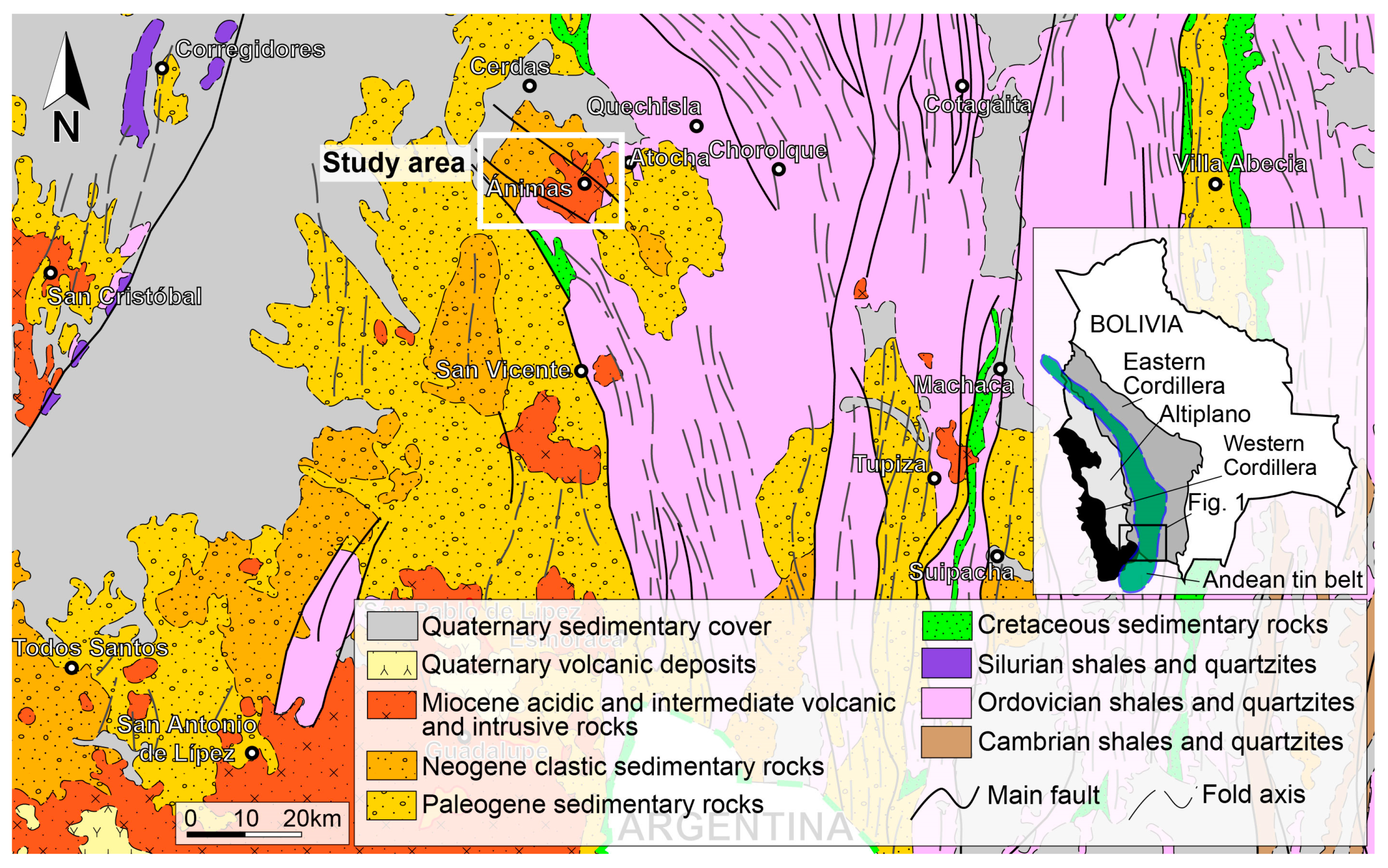
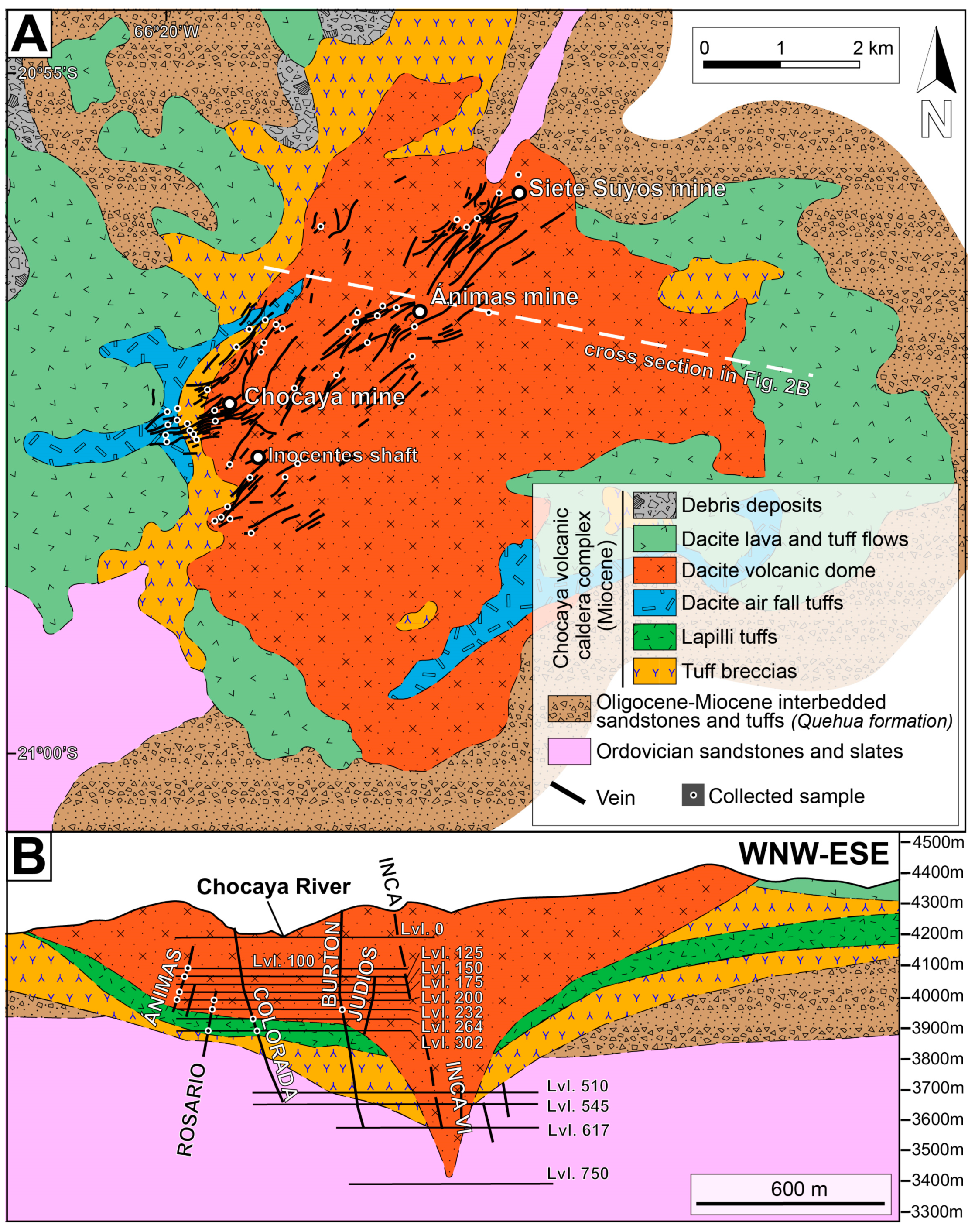
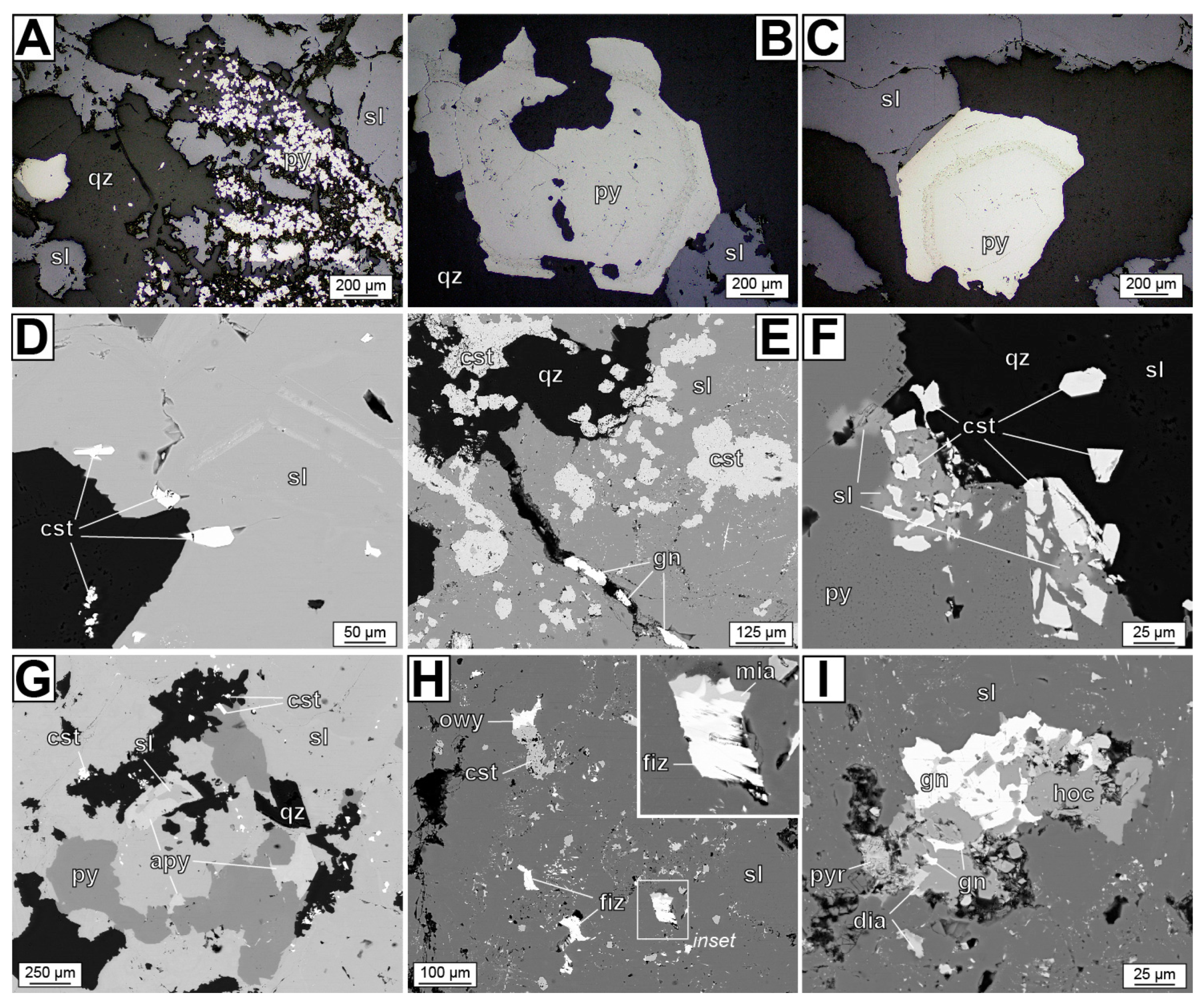
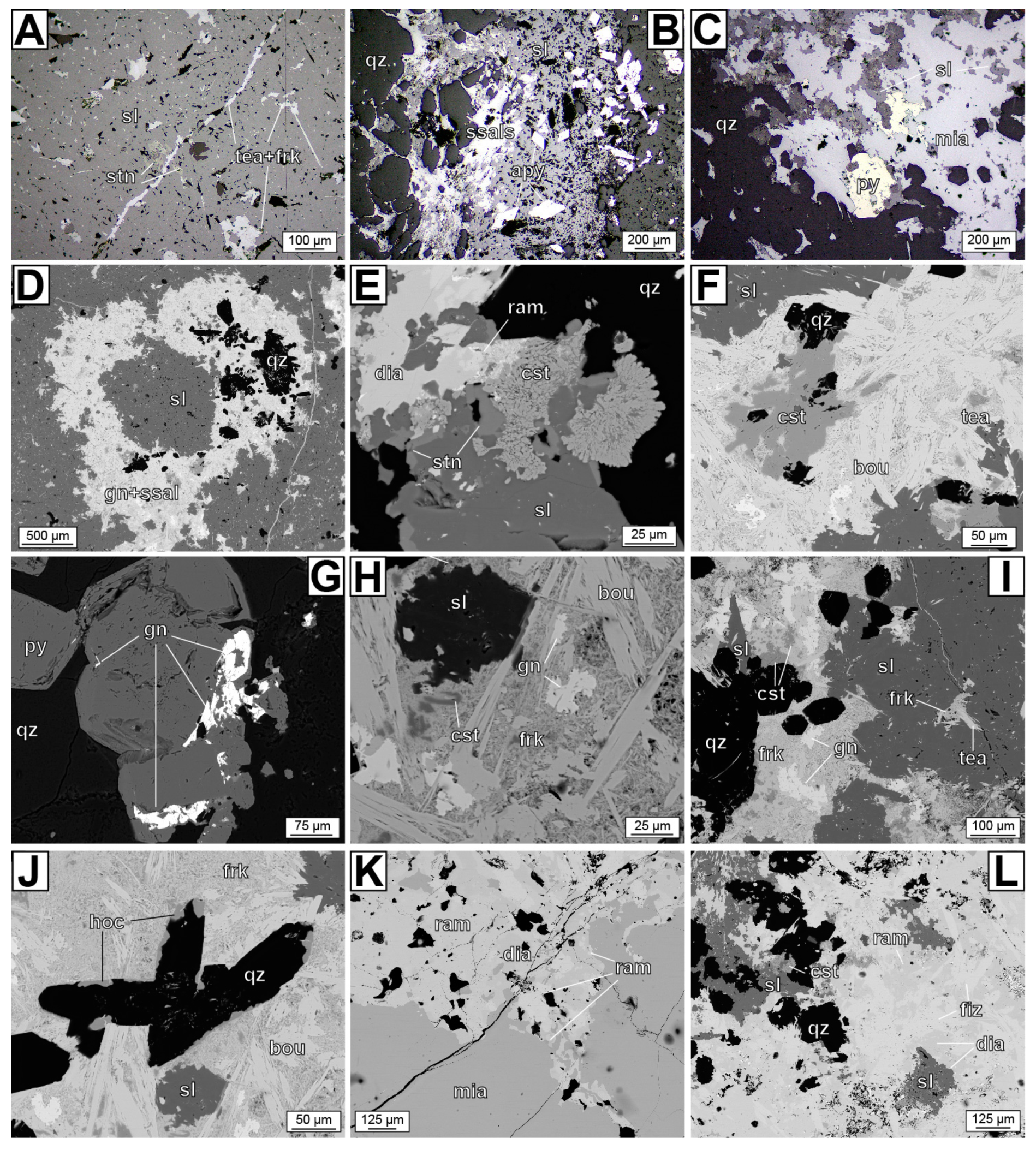
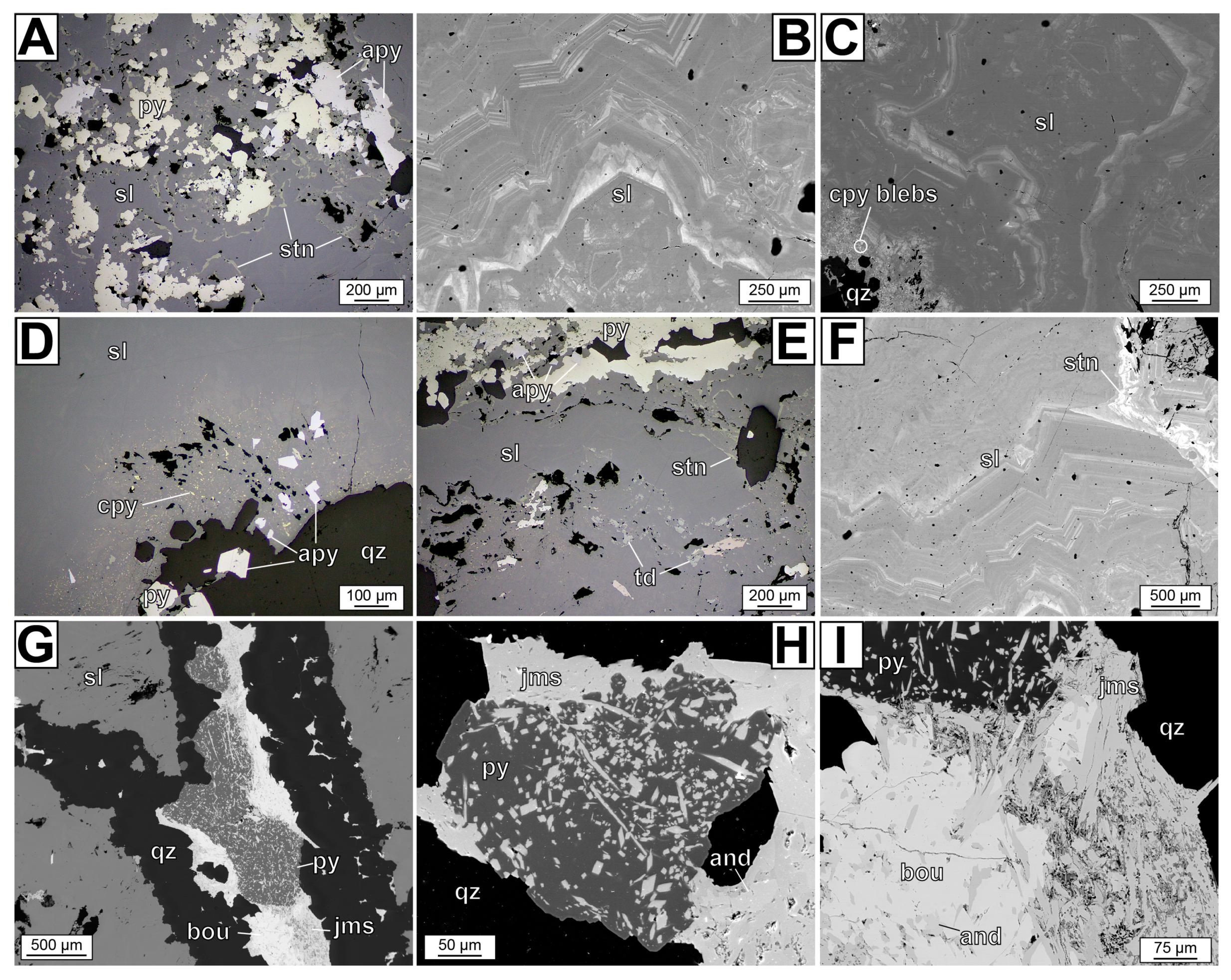
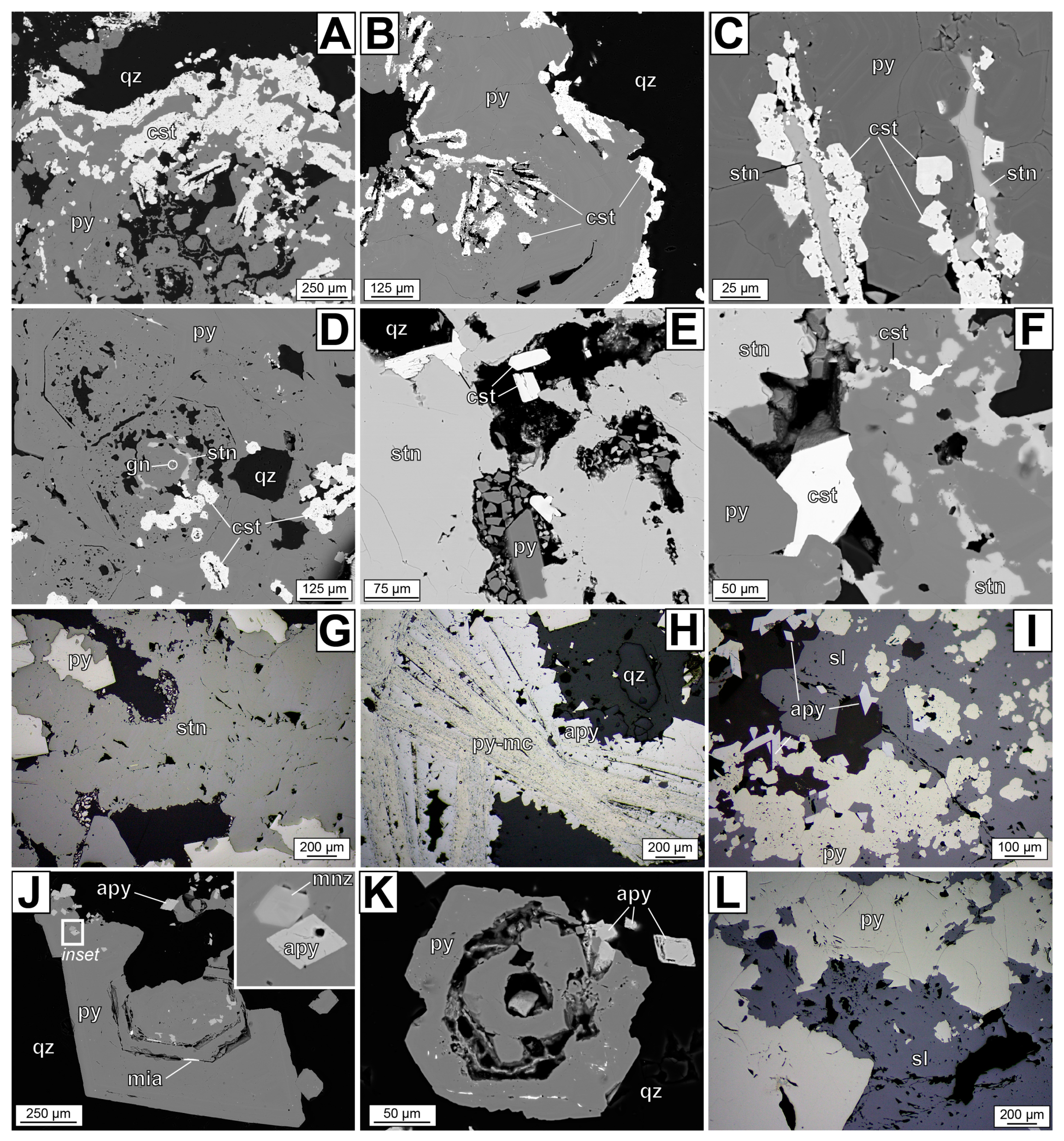
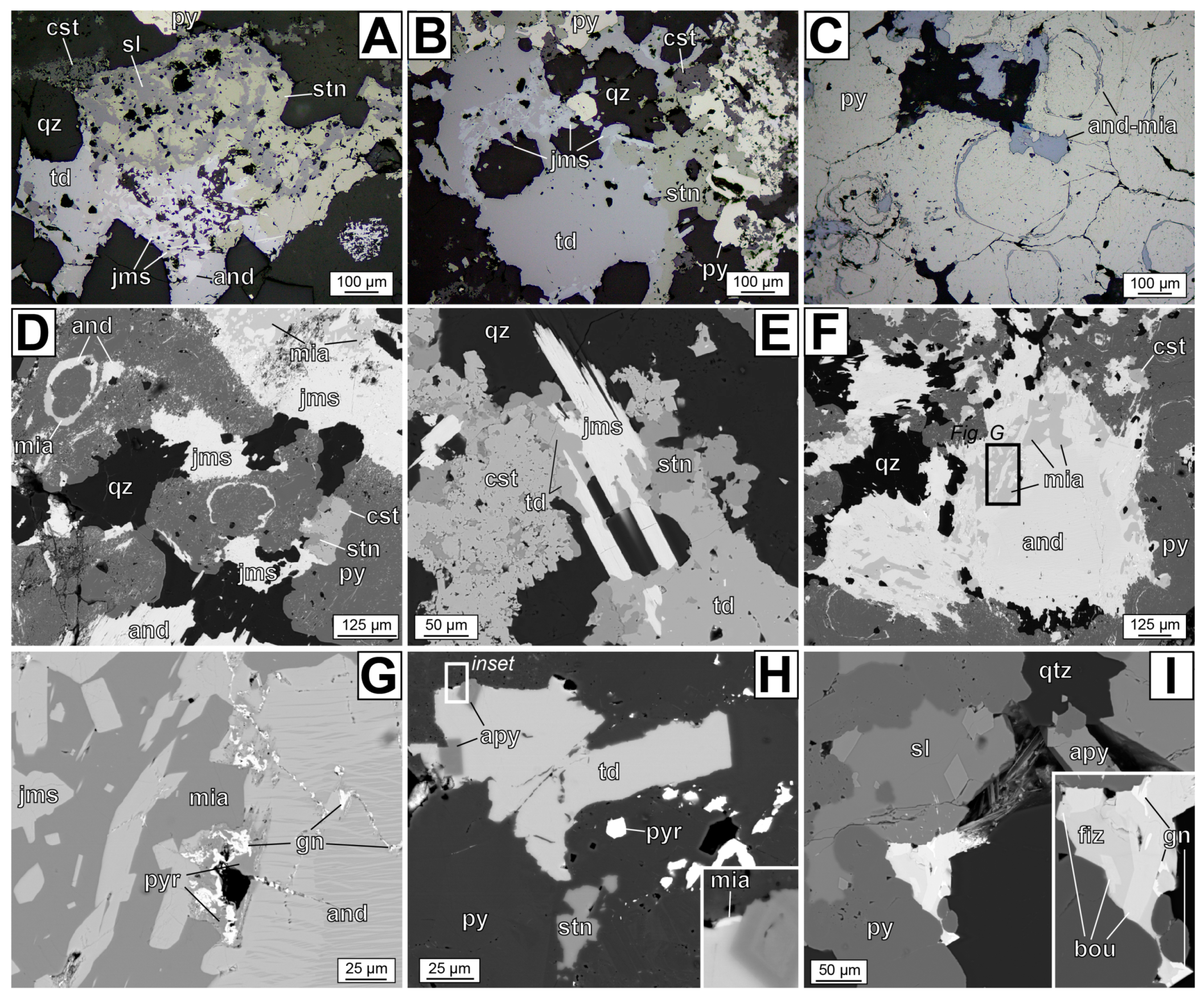
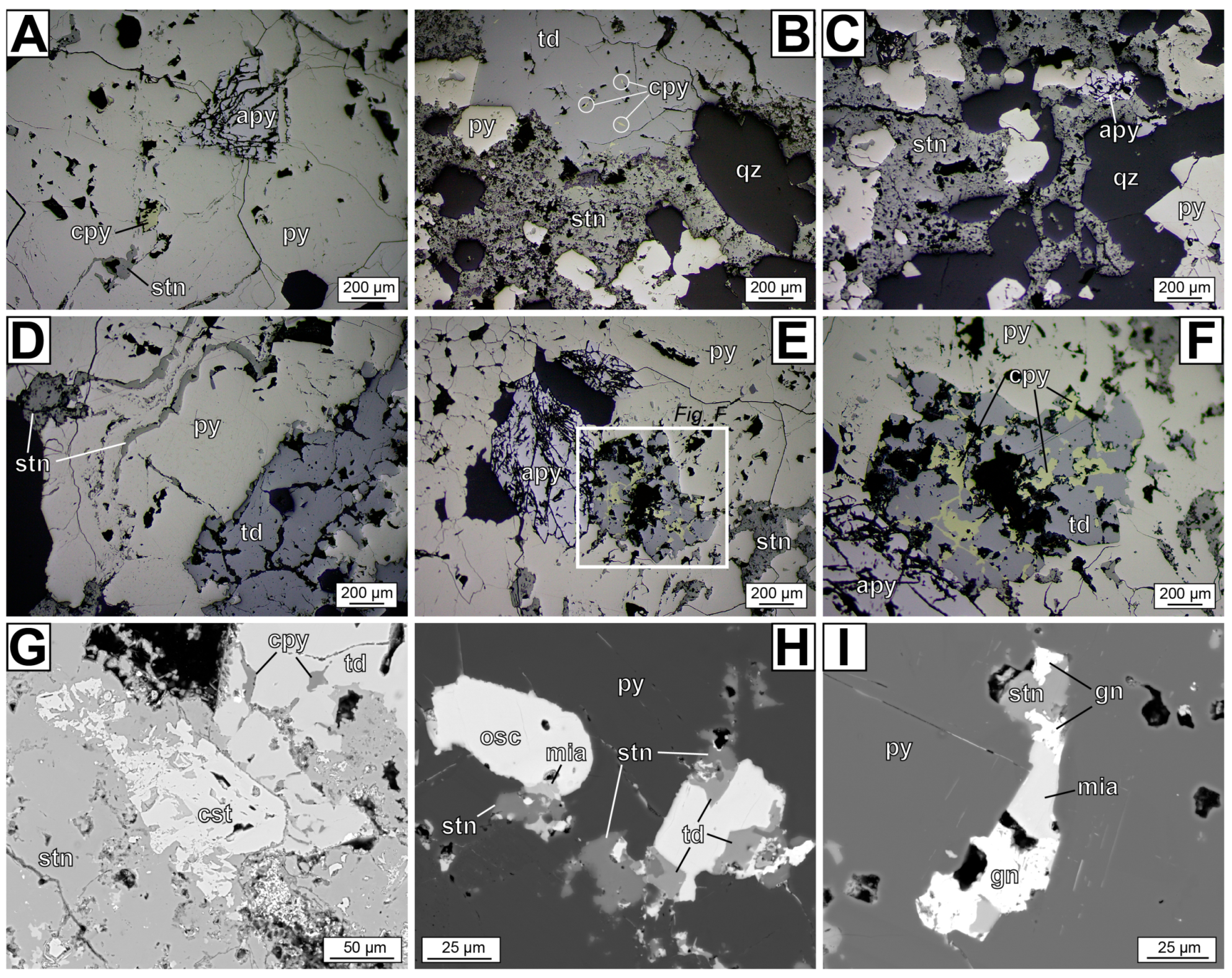
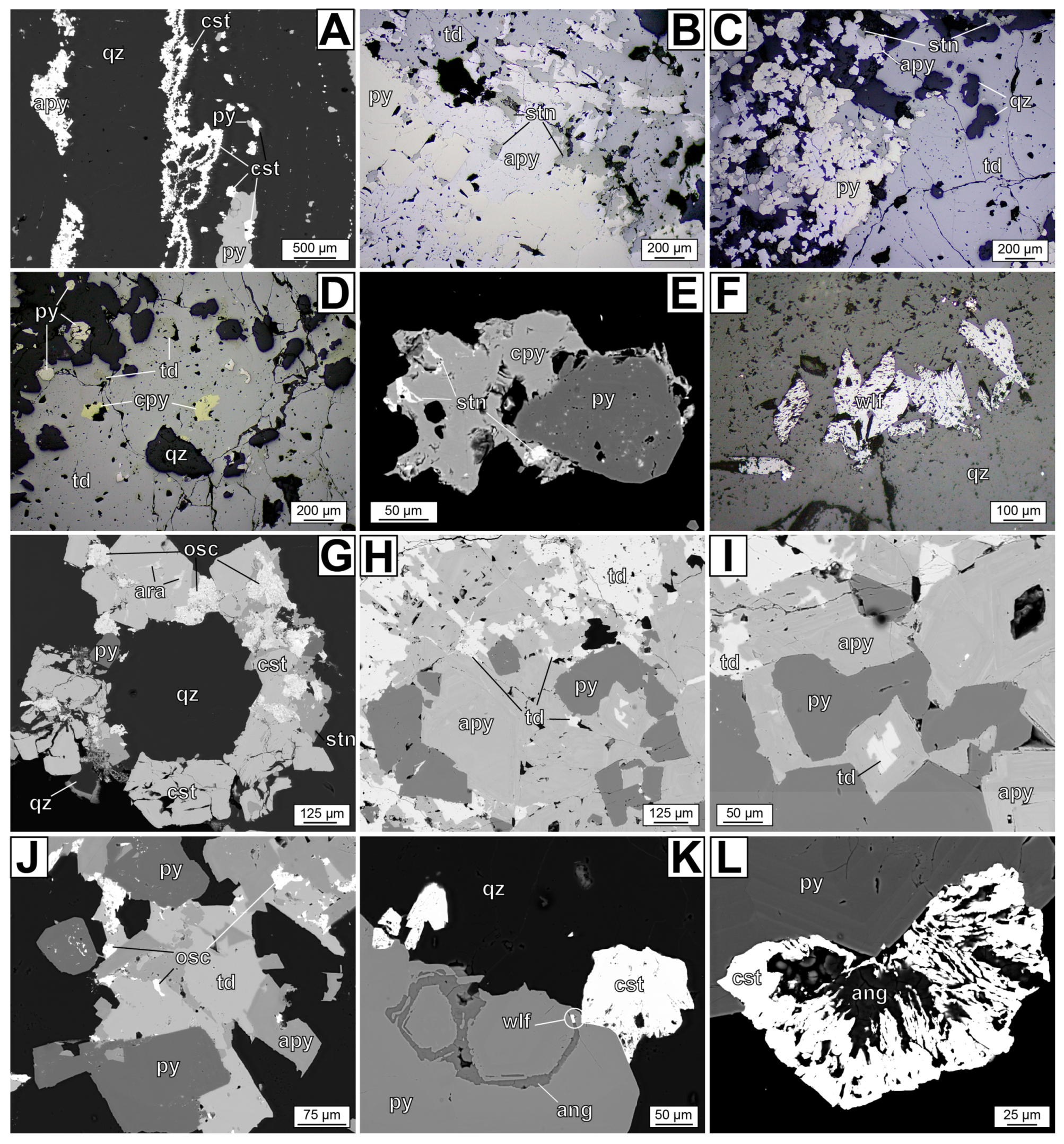
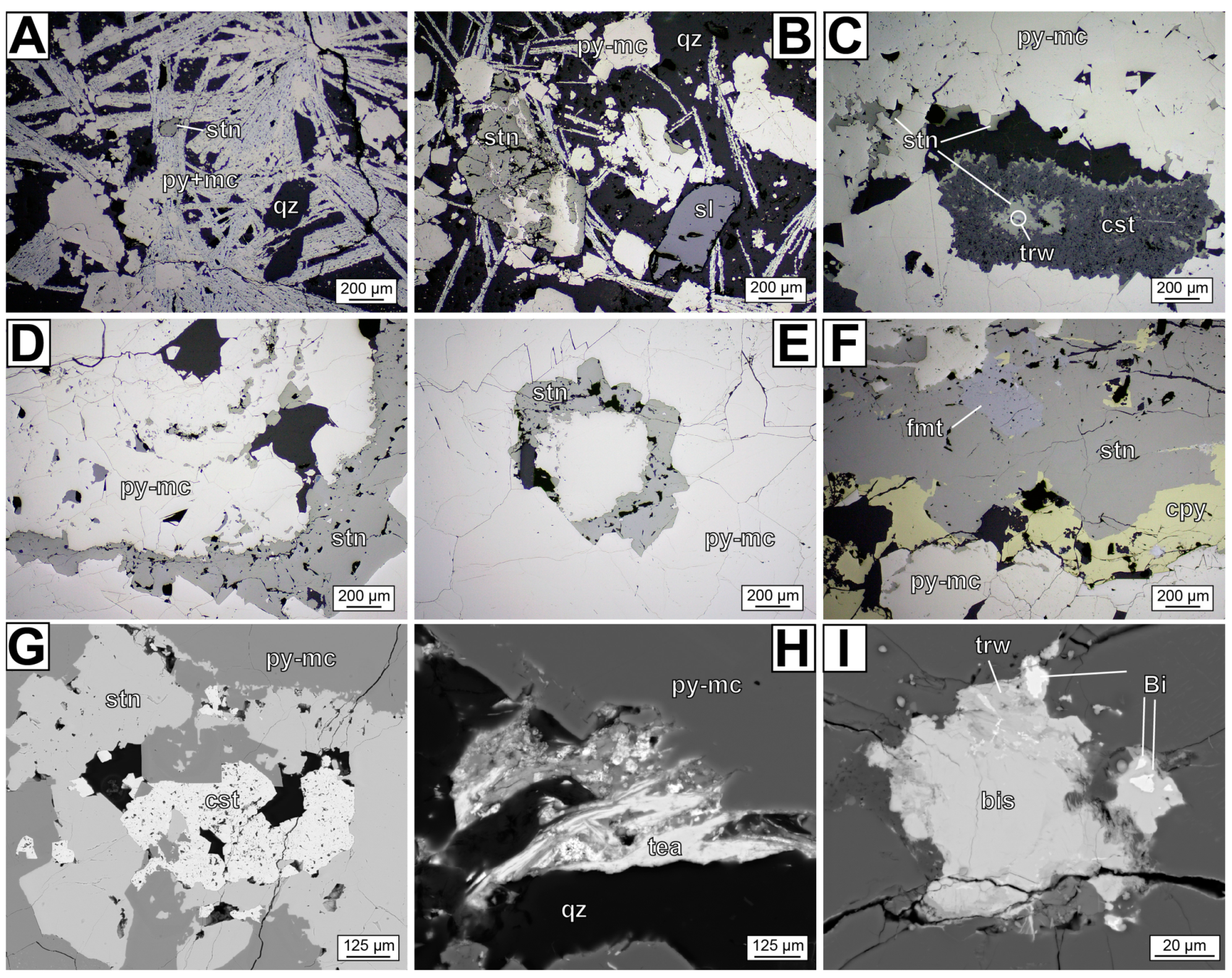

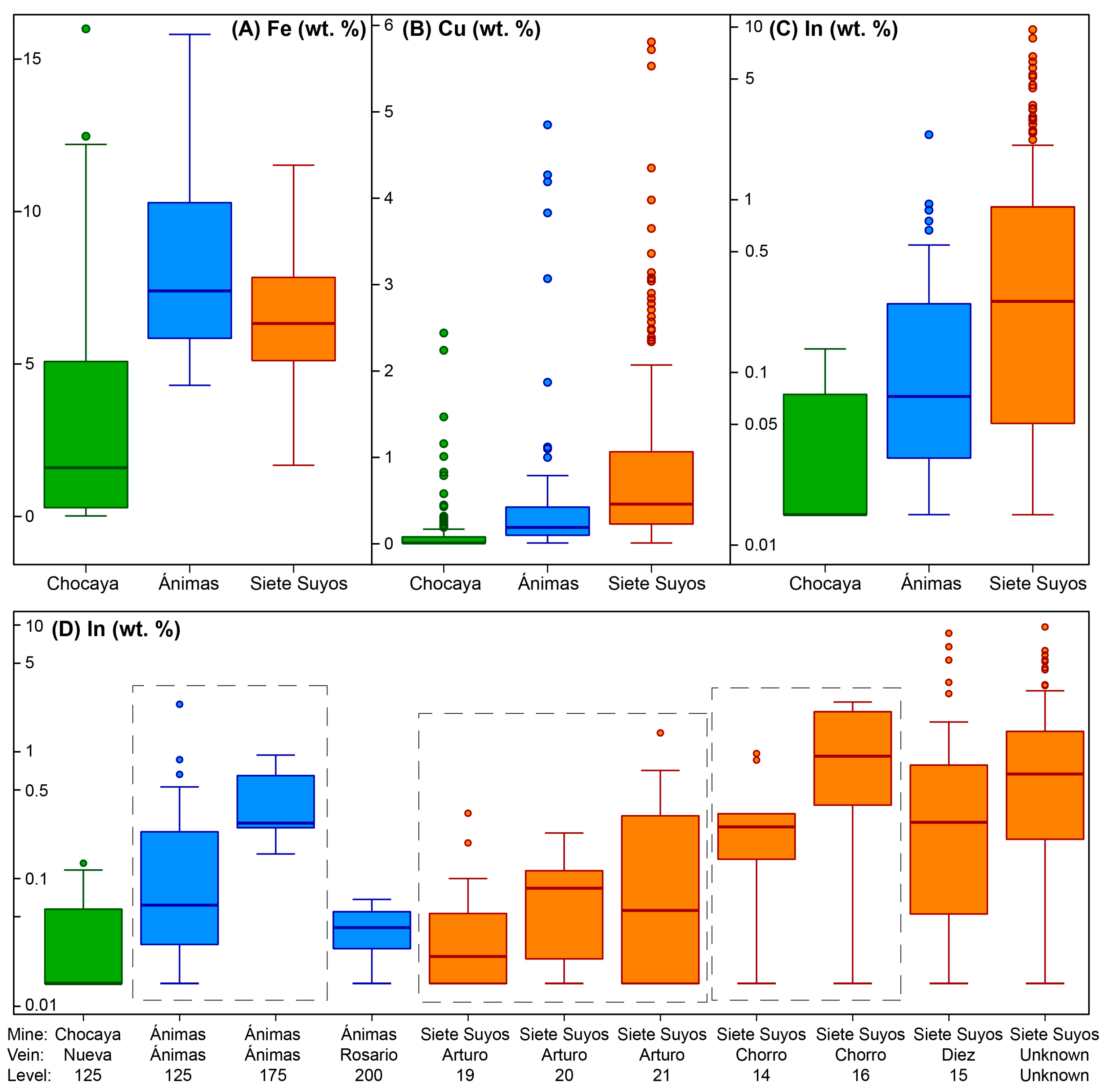
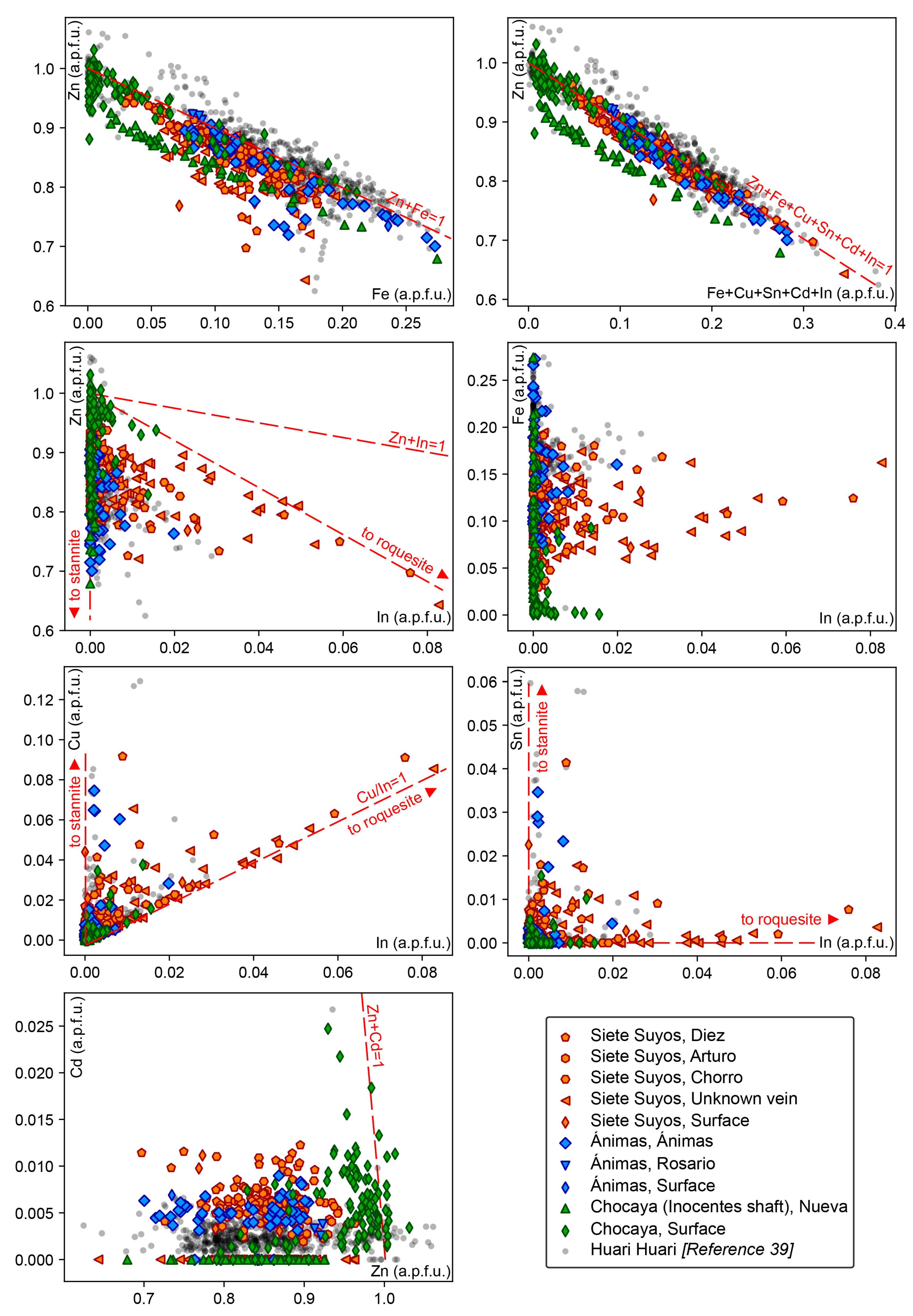
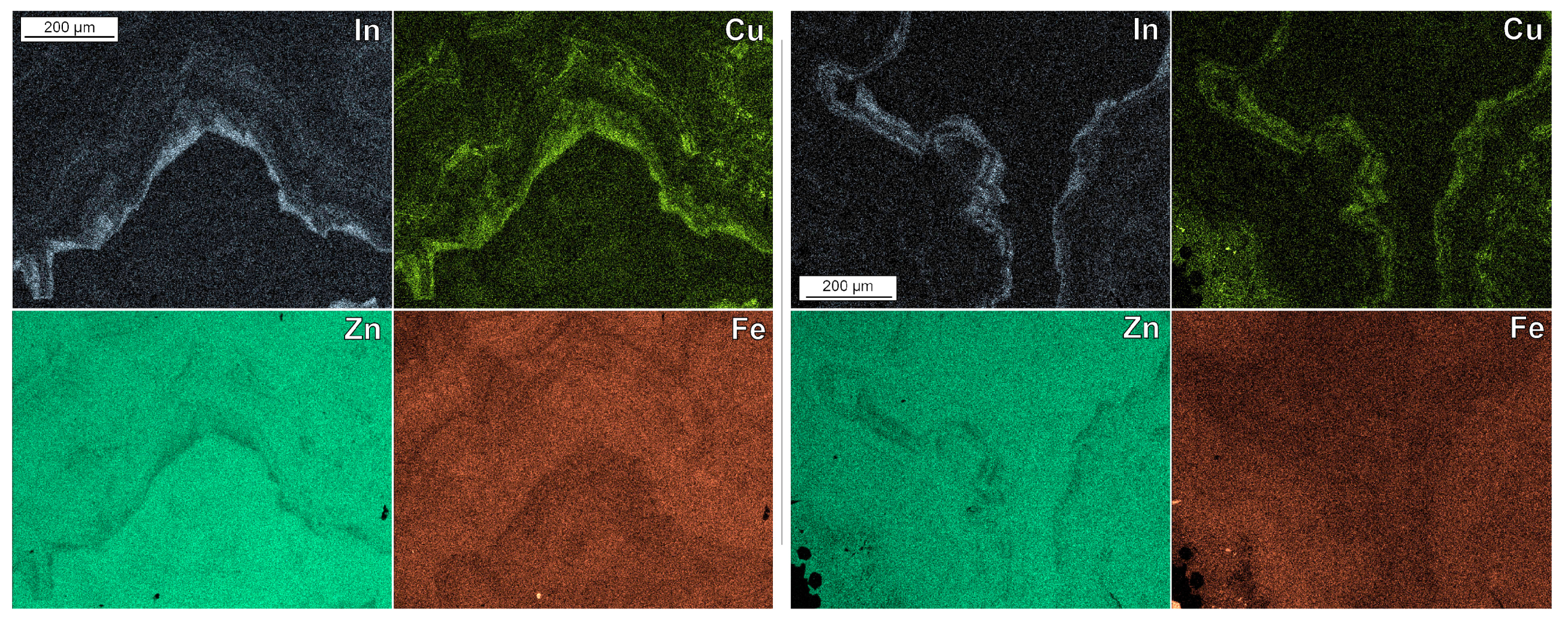
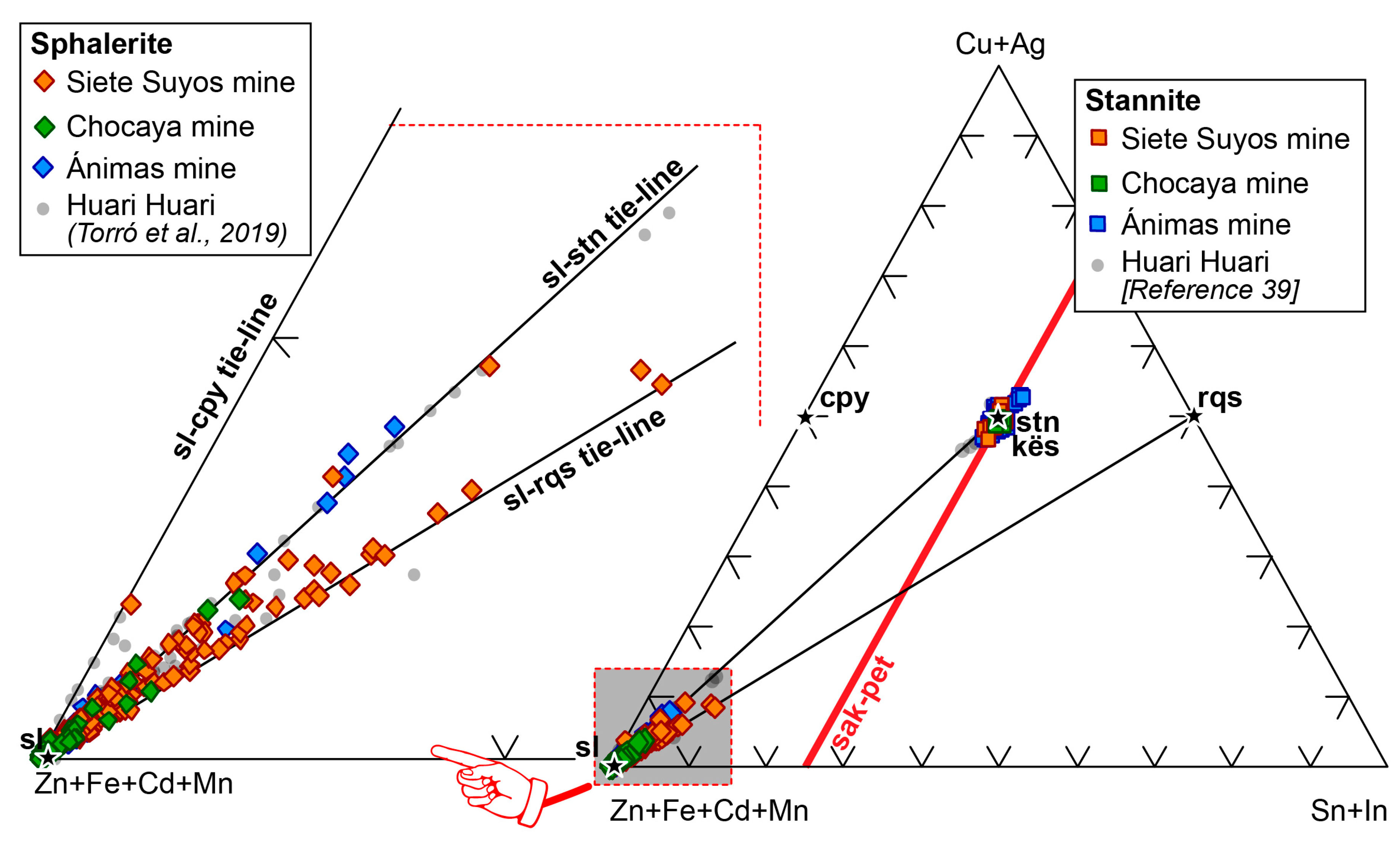
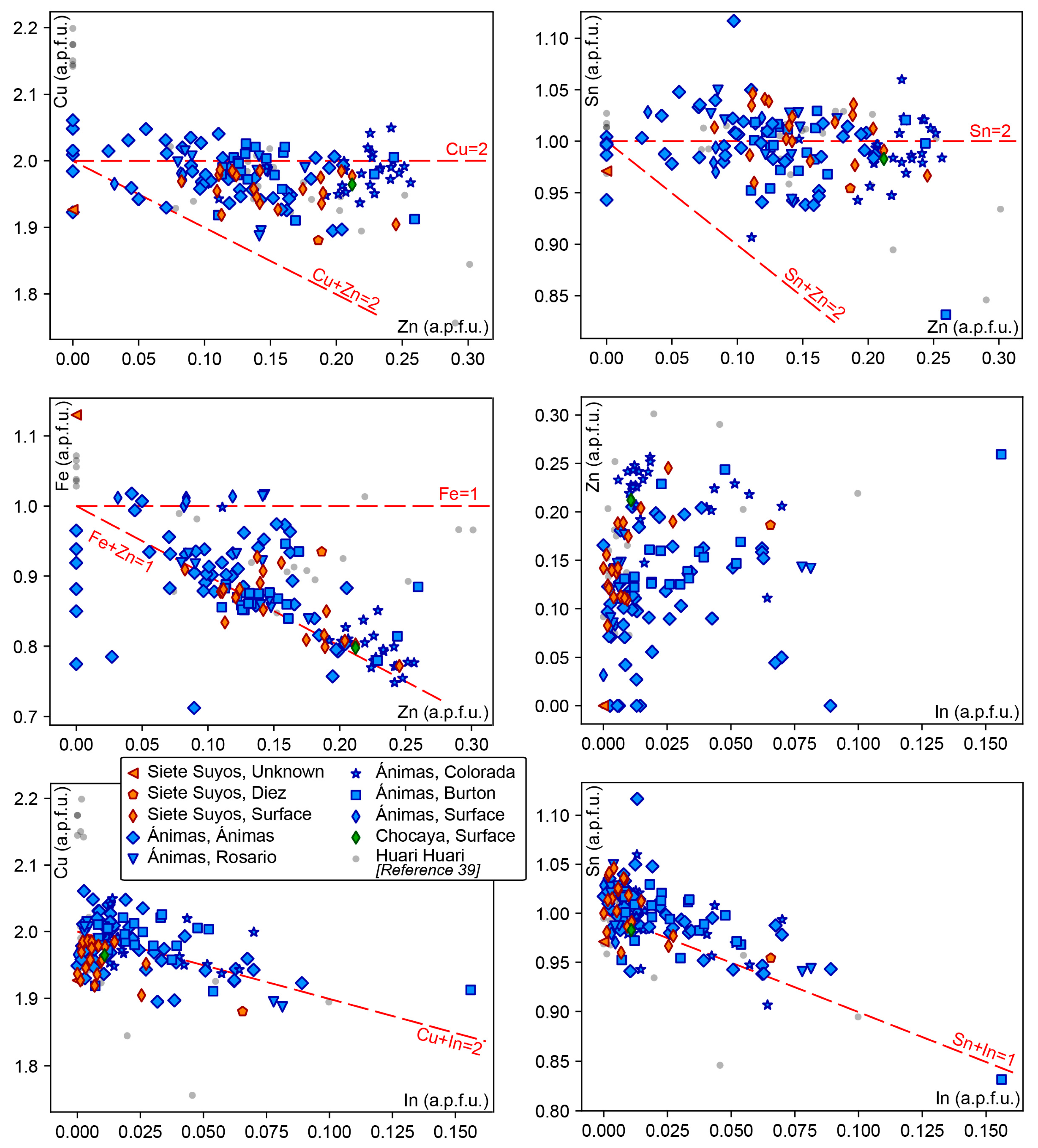
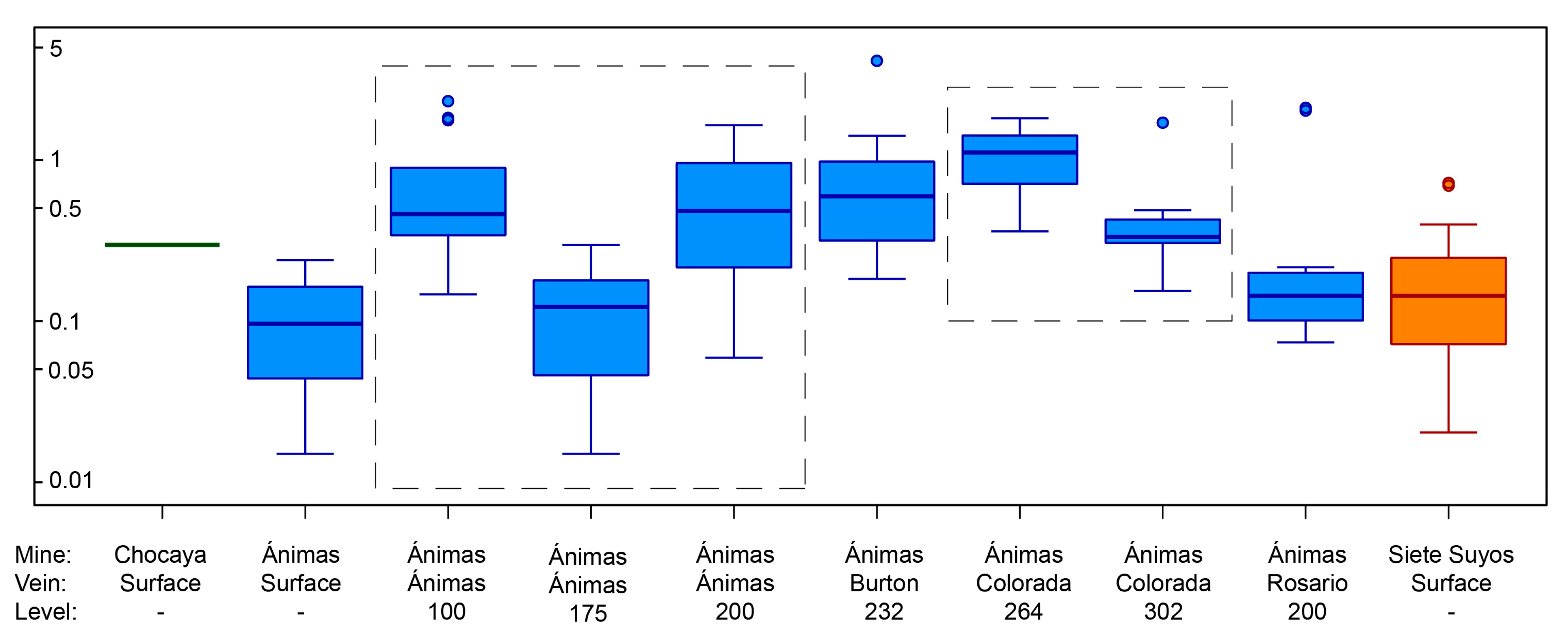
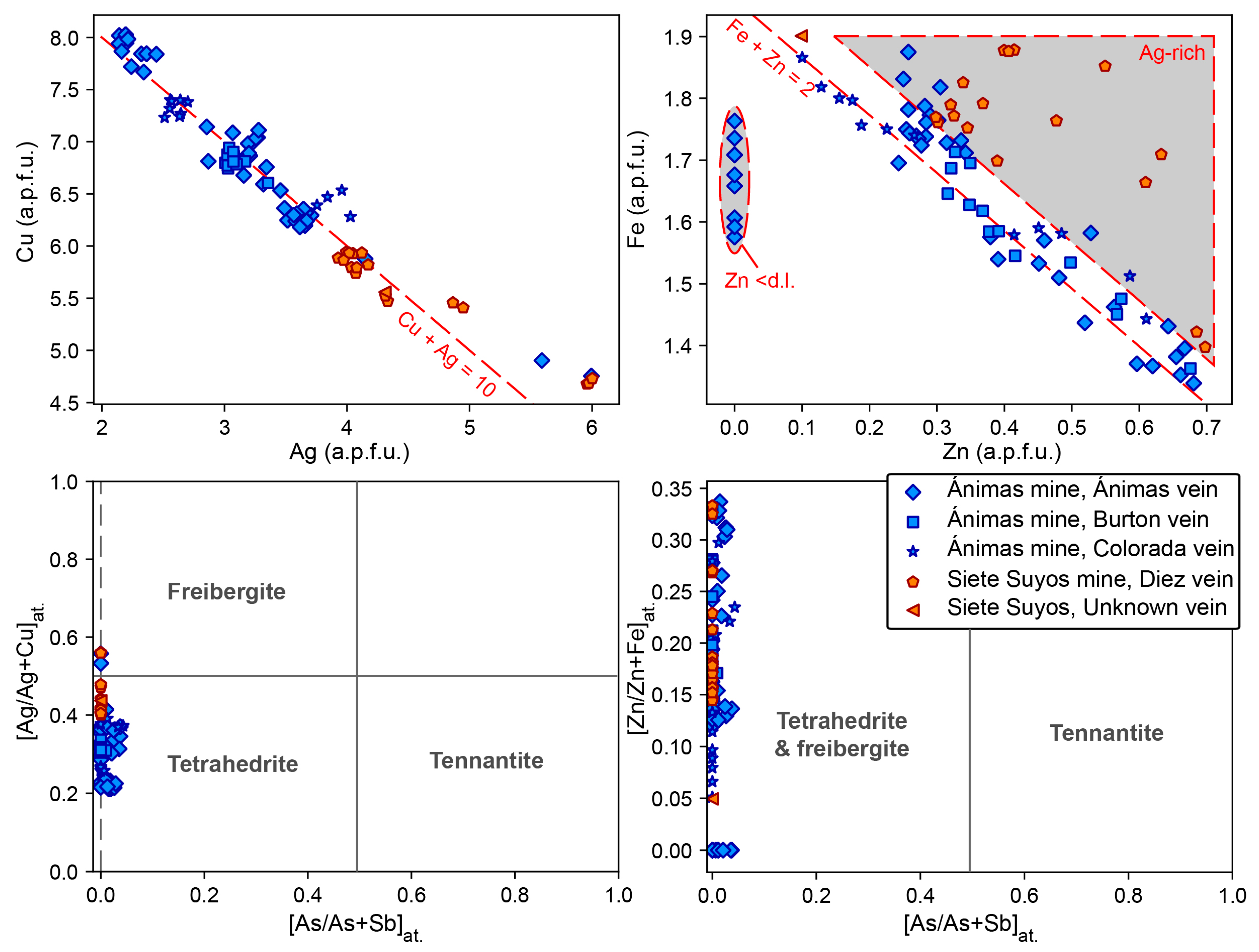
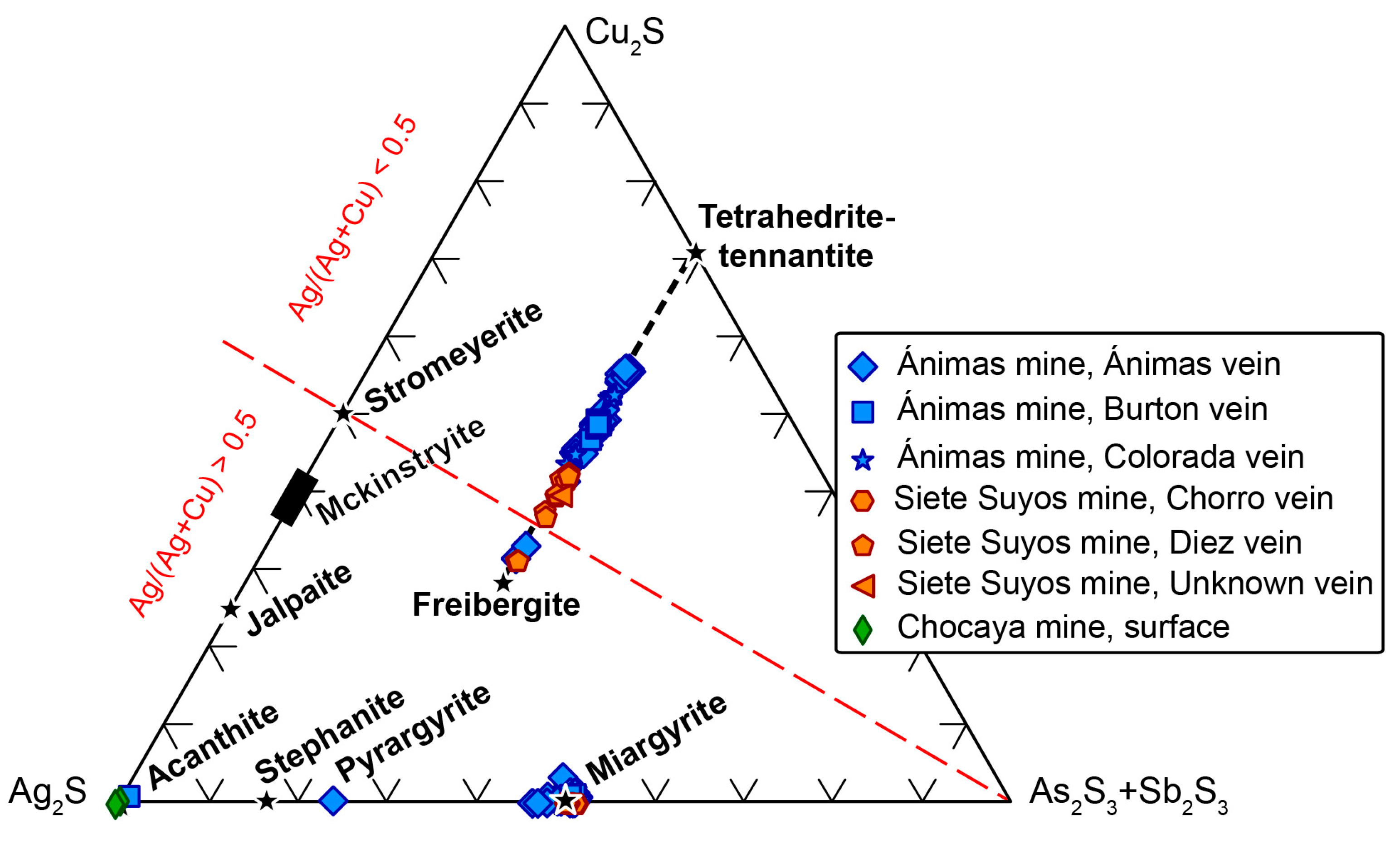
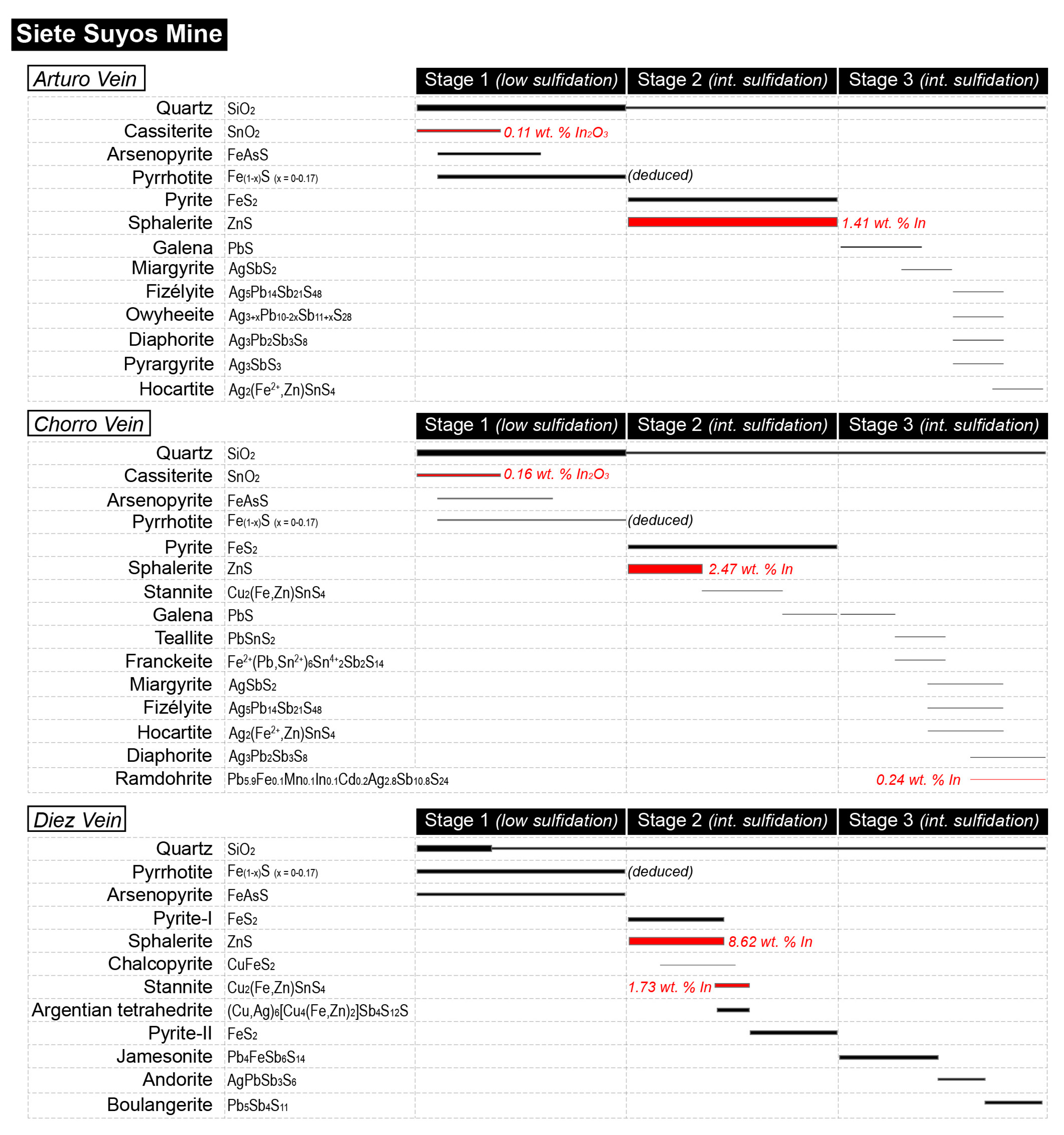
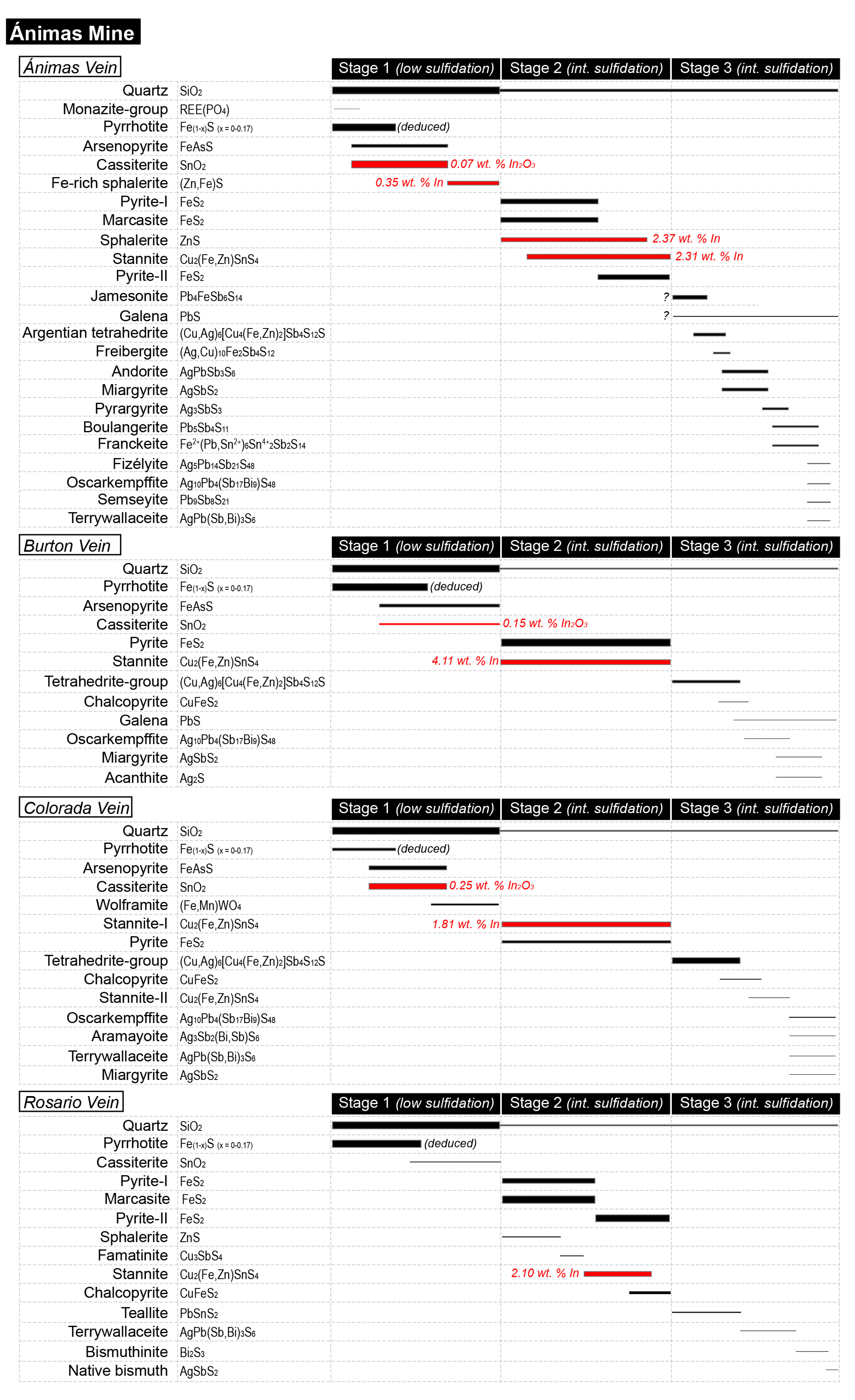
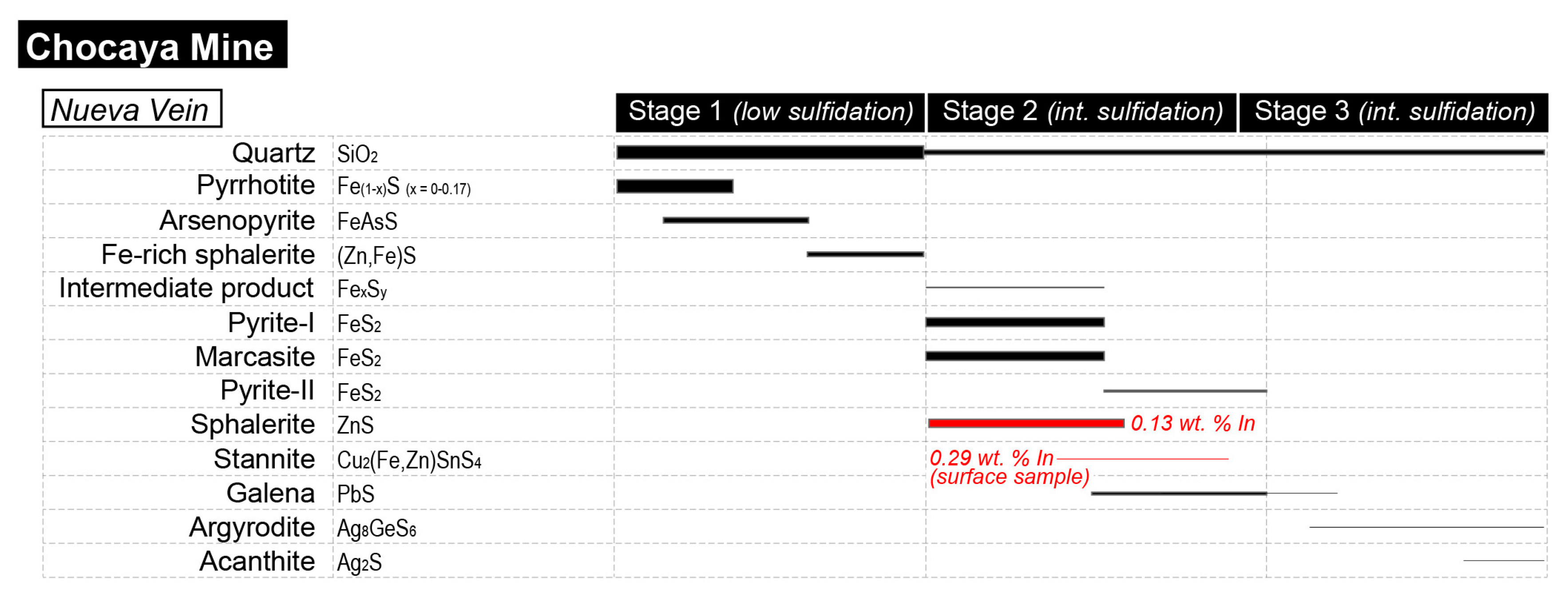
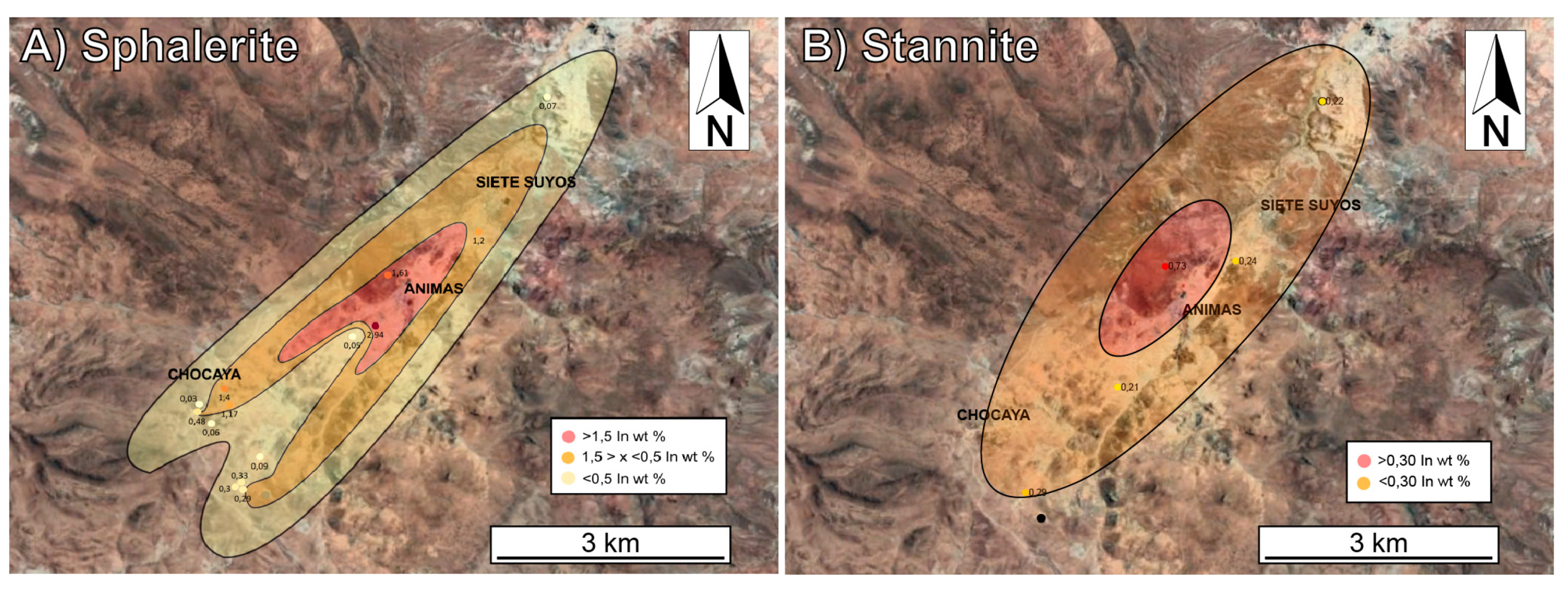
| Mine | Vein | Wt.% | S | Zn | Fe | Cu | Sn | Cd | Ag | In | Ge |
|---|---|---|---|---|---|---|---|---|---|---|---|
| d.l. | 0.01 | 0.03 | 0.02 | 0.02 | 0.04 | 0.08 | 0.06 | 0.03 | 0.02 | ||
| Entire district (n = 425) | MIN | 31.70 | 42.80 | 0.02 | b.d.l. | b.d.l. | b.d.l. | b.d.l. | b.d.l. | b.d.l. | |
| MAX | 34.39 | 67.50 | 15.99 | 5.81 | 4.90 | 2.82 | 3.09 | 9.66 | 0.07 | ||
| Av. | 33.04 | 58.76 | 5.49 | 0.56 | 0.25 | 0.46 | 0.04 | 0.50 | 0.00 | ||
| Ánimas mine | All samples (n = 56) | MIN | 32.01 | 47.55 | 4.30 | b.d.l. | b.d.l. | b.d.l. | b.d.l. | b.d.l. | b.d.l. |
| MAX | 34.34 | 61.51 | 15.81 | 4.85 | 4.21 | 1.04 | 0.83 | 2.37 | 0.04 | ||
| Av. | 33.20 | 56.08 | 8.35 | 0.62 | 0.40 | 0.54 | 0.05 | 0.21 | 0.00 | ||
| Surface (n = 2) | MIN | 33.29 | 49.88 | 9.40 | b.d.l. | b.d.l. | 0.68 | b.d.l. | b.d.l. | b.d.l. | |
| MAX | 33.61 | 56.89 | 13.68 | 0.10 | b.d.l. | 0.81 | b.d.l. | 0.05 | b.d.l. | ||
| Av. | 33.45 | 53.39 | 11.54 | 0.05 | - | 0.74 | - | 0.02 | - | ||
| Ánimas vein (n = 51) | MIN | 32.01 | 47.55 | 4.30 | b.d.l. | b.d.l. | b.d.l. | b.d.l. | b.d.l. | b.d.l. | |
| MAX | 34.34 | 60.36 | 15.81 | 4.85 | 4.21 | 1.04 | 0.83 | 2.37 | 0.04 | ||
| Av. | 33.22 | 55.89 | 8.43 | 0.67 | 0.43 | 0.54 | 0.05 | 0.23 | 0.00 | ||
| Ánimas vein, level 125 (n = 42) | MIN | 32.39 | 47.55 | 4.30 | b.d.l. | b.d.l. | b.d.l. | b.d.l. | b.d.l. | b.d.l. | |
| MAX | 34.34 | 60.36 | 15.81 | 1.87 | 0.89 | 1.04 | 0.19 | 2.37 | 0.04 | ||
| Av. | 33.28 | 56.33 | 8.70 | 0.25 | 0.11 | 0.53 | 0.02 | 0.20 | 0.00 | ||
| Ánimas vein, level 175 (n = 7) | MIN | 32.01 | 48.15 | 4.84 | 0.54 | 0.24 | 0.43 | b.d.l. | 0.16 | b.d.l. | |
| MAX | 33.47 | 59.11 | 9.77 | 4.85 | 4.21 | 0.76 | 0.83 | 0.94 | b.d.l. | ||
| Av. | 32.87 | 52.07 | 7.80 | 3.12 | 2.36 | 0.59 | 0.25 | 0.45 | - | ||
| Ánimas vein, level 200 (n = 2) | MIN | 33.09 | 59.79 | 4.78 | 0.79 | 0.26 | 0.37 | b.d.l. | 0.11 | b.d.l. | |
| MAX | 33.13 | 60.17 | 4.79 | 1.00 | 0.45 | 0.60 | b.d.l. | 0.12 | b.d.l. | ||
| Av. | 33.11 | 59.98 | 4.79 | 0.90 | 0.35 | 0.48 | - | 0.11 | - | ||
| Rosario vein, level 200 (n = 3) | MIN | 32.46 | 60.95 | 4.69 | 0.02 | 0.04 | 0.30 | b.d.l. | b.d.l. | b.d.l. | |
| MAX | 32.74 | 61.51 | 5.11 | 0.10 | 0.06 | 0.44 | b.d.l. | 0.07 | b.d.l. | ||
| Av. | 32.63 | 61.14 | 4.91 | 0.06 | 0.05 | 0.37 | - | 0.04 | - | ||
| Chocaya mine | All samples (n = 149) | MIN | 31.78 | 46.34 | 0.02 | b.d.l. | b.d.l. | b.d.l. | b.d.l. | b.d.l. | b.d.l. |
| MAX | 34.39 | 67.50 | 15.99 | 2.44 | 1.87 | 2.82 | 0.79 | 1.82 | 0.03 | ||
| Av. | 32.92 | 61.60 | 3.02 | 0.12 | 0.05 | 0.48 | 0.03 | 0.11 | 0.00 | ||
| Surface (n = 106) | MIN | 31.78 | 53.45 | 0.02 | b.d.l. | b.d.l. | b.d.l. | b.d.l. | b.d.l. | b.d.l. | |
| MAX | 34.39 | 67.50 | 12.20 | 2.44 | 1.87 | 2.82 | 0.79 | 1.82 | 0.03 | ||
| Av. | 32.78 | 63.31 | 2.18 | 0.15 | 0.06 | 0.67 | 0.03 | 0.14 | 0.00 | ||
| Nueva vein, 125 level (n = 43) | MIN | 32.70 | 46.34 | 1.03 | b.d.l. | b.d.l. | n.a. | b.d.l. | b.d.l. | n.a. | |
| MAX | 33.76 | 62.05 | 15.99 | 0.21 | 0.27 | n.a. | 0.28 | 0.13 | n.a. | ||
| Av. | 33.24 | 57.40 | 5.08 | 0.02 | 0.02 | - | 0.03 | 0.03 | - | ||
| Siete Suyos mine | All samples (n = 220) | MIN | 31.70 | 42.80 | 1.68 | b.d.l. | b.d.l. | b.d.l. | b.d.l. | b.d.l. | b.d.l. |
| MAX | 34.32 | 63.79 | 11.52 | 5.81 | 4.90 | 1.41 | 3.09 | 9.66 | 0.07 | ||
| Av. | 33.08 | 57.51 | 6.44 | 0.85 | 0.34 | 0.44 | 0.04 | 0.83 | 0.00 | ||
| Surface (n = 13) | MIN | 32.04 | 50.77 | 4.13 | 0.19 | 0.13 | 0.35 | b.d.l. | b.d.l. | b.d.l. | |
| MAX | 33.31 | 60.39 | 8.45 | 2.84 | 2.72 | 1.26 | 0.26 | 2.94 | 0.07 | ||
| Av. | 32.75 | 57.22 | 5.97 | 1.10 | 0.66 | 0.68 | 0.08 | 0.67 | 0.01 | ||
| Arturo vein (n = 59) | MIN | 32.34 | 53.21 | 2.97 | b.d.l. | b.d.l. | b.d.l. | b.d.l. | b.d.l. | b.d.l. | |
| MAX | 33.91 | 63.08 | 10.78 | 1.96 | 1.70 | 0.92 | 3.09 | 1.41 | b.d.l. | ||
| Av. | 33.25 | 58.38 | 6.89 | 0.27 | 0.15 | 0.58 | 0.08 | 0.13 | - | ||
| Arturo vein, 19 level (n = 16) | MIN | 32.46 | 53.21 | 4.92 | 0.18 | b.d.l. | 0.48 | b.d.l. | b.d.l. | b.d.l. | |
| MAX | 33.64 | 60.62 | 8.48 | 0.70 | 0.62 | 0.73 | 3.09 | 0.33 | b.d.l. | ||
| Av. | 33.04 | 57.96 | 7.16 | 0.40 | 0.28 | 0.62 | 0.21 | 0.05 | - | ||
| Arturo vein, 20 level (n = 16) | MIN | 32.34 | 54.16 | 3.07 | b.d.l. | b.d.l. | 0.31 | b.d.l. | b.d.l. | b.d.l. | |
| MAX | 33.91 | 62.58 | 10.25 | 0.38 | 0.25 | 0.91 | 0.26 | 0.23 | b.d.l. | ||
| Av. | 33.28 | 58.53 | 6.75 | 0.15 | 0.09 | 0.58 | 0.02 | 0.08 | - | ||
| Arturo vein, 21 level (n = 27) | MIN | 32.57 | 54.03 | 2.97 | b.d.l. | b.d.l. | b.d.l. | b.d.l. | b.d.l. | b.d.l. | |
| MAX | 33.80 | 63.08 | 10.78 | 1.96 | 1.70 | 0.92 | 0.43 | 1.41 | b.d.l. | ||
| Av. | 33.35 | 58.55 | 6.80 | 0.27 | 0.12 | 0.55 | 0.03 | 0.22 | - | ||
| Siete Suyos mine | Chorro vein (n = 18) | MIN | 32.29 | 52.59 | 1.68 | 0.22 | 0.00 | 0.43 | 0.00 | 0.00 | 0.00 |
| MAX | 33.01 | 63.47 | 8.95 | 1.63 | 1.27 | 1.26 | 0.34 | 2.47 | 0.00 | ||
| Av. | 32.69 | 59.91 | 4.10 | 0.78 | 0.33 | 0.76 | 0.06 | 0.72 | 0.00 | ||
| Chorro vein, 14 level (n = 9) | MIN | 32.31 | 56.78 | 1.92 | 0.22 | 0.05 | 0.43 | 0.00 | 0.00 | 0.00 | |
| MAX | 33.01 | 63.47 | 6.94 | 1.45 | 1.27 | 1.26 | 0.12 | 0.97 | 0.00 | ||
| Av. | 32.69 | 61.29 | 3.44 | 0.56 | 0.30 | 0.68 | 0.02 | 0.35 | 0.00 | ||
| Chorro vein, 16 level (n = 9) | MIN | 32.29 | 52.59 | 1.68 | 0.28 | 0.00 | 0.57 | 0.00 | 0.00 | 0.00 | |
| MAX | 32.97 | 62.65 | 8.95 | 1.63 | 0.98 | 1.26 | 0.34 | 2.47 | 0.00 | ||
| Av. | 32.69 | 58.53 | 4.75 | 0.99 | 0.36 | 0.84 | 0.10 | 1.10 | 0.00 | ||
| Diez vein, 15 level (n = 46) | MIN | 31.70 | 45.07 | 4.40 | 0.00 | 0.00 | 0.25 | 0.00 | 0.00 | 0.00 | |
| MAX | 33.57 | 61.39 | 11.00 | 5.81 | 4.90 | 1.41 | 0.25 | 8.62 | 0.00 | ||
| Av. | 32.79 | 55.71 | 7.15 | 1.19 | 0.59 | 0.85 | 0.04 | 0.91 | 0.00 | ||
| Unknown vein (n = 84) | MIN | 31.70 | 42.80 | 1.72 | 0.00 | 0.00 | 0.00 | 0.00 | 0.00 | 0.00 | |
| MAX | 34.32 | 63.79 | 11.52 | 5.53 | 2.20 | 0.00 | 0.26 | 9.66 | 0.00 | ||
| Av. | 33.24 | 57.41 | 6.31 | 1.06 | 0.29 | 0.00 | 0.01 | 1.32 | 0.00 | ||
| Mine | Vein | Wt.% | S | Cu | Sn | Fe | Zn | Sb | Ag | In | Ge |
|---|---|---|---|---|---|---|---|---|---|---|---|
| d.l. | 0.01 | 0.02 | 0.04 | 0.02 | 0.03 | 0.04 | 0.06 | 0.03 | 0.02 | ||
| Entire district (n = 157) | MIN | 27.22 | 26.96 | 22.64 | 9.25 | b.d.l. | b.d.l. | b.d.l. | b.d.l. | b.d.l. | |
| MAX | 30.15 | 30.07 | 28.39 | 13.91 | 3.89 | 2.16 | 3.12 | 4.11 | 0.14 | ||
| Av. | 29.19 | 28.61 | 26.93 | 11.13 | 2.13 | 0.10 | 0.40 | 0.59 | 0.00 | ||
| Ánimas mine | All samples (n = 135) | MIN | 27.22 | 26.96 | 22.64 | 9.25 | b.d.l. | b.d.l. | b.d.l. | b.d.l. | b.d.l. |
| MAX | 30.15 | 30.07 | 28.26 | 13.05 | 3.89 | 2.16 | 3.12 | 4.11 | 0.14 | ||
| Av. | 29.16 | 28.63 | 26.87 | 11.14 | 2.11 | 0.10 | 0.38 | 0.64 | 0.00 | ||
| Surface (n = 5) | MIN | 28.75 | 28.35 | 26.60 | 12.69 | 0.47 | b.d.l. | 0.15 | b.d.l. | b.d.l. | |
| MAX | 29.62 | 28.96 | 27.72 | 13.05 | 1.74 | b.d.l. | 0.33 | 0.21 | b.d.l. | ||
| Av. | 29.27 | 28.68 | 27.06 | 12.86 | 1.19 | - | 0.23 | 0.10 | - | ||
| Ánimas vein (n = 65) | MIN | 27.22 | 27.34 | 25.16 | 9.25 | b.d.l. | b.d.l. | b.d.l. | b.d.l. | b.d.l. | |
| MAX | 30.15 | 30.07 | 28.26 | 12.75 | 3.05 | 0.57 | 1.02 | 2.31 | 0.14 | ||
| Av. | 29.17 | 28.65 | 27.01 | 11.42 | 1.60 | 0.02 | 0.25 | 0.61 | 0.01 | ||
| Ánimas vein, 100 level (n = 24) | MIN | 28.58 | 27.59 | 25.16 | 9.25 | b.d.l. | b.d.l. | b.d.l. | 0.15 | b.d.l. | |
| MAX | 29.82 | 30.07 | 27.78 | 12.75 | 2.99 | 0.57 | 1.02 | 2.31 | 0.14 | ||
| Av. | 29.33 | 28.77 | 26.85 | 11.08 | 1.60 | 0.05 | 0.23 | 0.75 | 0.02 | ||
| Ánimas vein, 125 level (n = 1) | Value | 29.28 | 28.19 | 26.70 | 11.39 | 2.45 | b.d.l. | 0.51 | 0.71 | b.d.l. | |
| Ánimas vein, 175 level (n = 8) | MIN | 29.51 | 28.53 | 26.91 | 10.79 | 1.47 | b.d.l. | b.d.l. | b.d.l. | b.d.l. | |
| MAX | 29.87 | 29.14 | 28.26 | 12.39 | 2.72 | 0.16 | 0.44 | 0.30 | b.d.l. | ||
| Av. | 29.65 | 28.83 | 27.72 | 11.49 | 1.93 | 0.03 | 0.23 | 0.12 | - | ||
| Ánimas vein, 200 level (n = 32) | MIN | 27.22 | 27.34 | 25.33 | 10.16 | b.d.l. | b.d.l. | b.d.l. | 0.06 | b.d.l. | |
| MAX | 30.15 | 29.91 | 28.14 | 12.59 | 3.05 | 0.05 | 0.56 | 1.64 | b.d.l. | ||
| Av. | 28.92 | 28.52 | 26.97 | 11.66 | 1.49 | 0.00 | 0.27 | 0.62 | - | ||
| Burton vein, 232 level (n = 21) | MIN | 28.57 | 27.35 | 22.64 | 9.90 | 1.62 | b.d.l. | b.d.l. | 0.18 | b.d.l. | |
| MAX | 29.55 | 29.28 | 27.66 | 11.96 | 3.89 | 2.16 | 3.12 | 4.11 | b.d.l. | ||
| Av. | 29.09 | 28.60 | 26.60 | 10.98 | 2.24 | 0.25 | 0.56 | 0.83 | - | ||
| Colorada vein, (n = 33) | MIN | 28.50 | 27.51 | 24.79 | 9.42 | 1.67 | b.d.l. | b.d.l. | 0.15 | b.d.l. | |
| MAX | 30.00 | 29.35 | 27.96 | 12.84 | 3.88 | 1.54 | 2.74 | 1.81 | 0.04 | ||
| Av. | 29.21 | 28.67 | 26.68 | 10.25 | 3.24 | 0.21 | 0.52 | 0.74 | - | ||
| Colorada vein, 264 level, (n = 16) | MIN | 28.50 | 27.51 | 24.87 | 9.42 | 2.79 | b.d.l. | 0.16 | 0.36 | n.a. | |
| MAX | 29.07 | 29.35 | 27.31 | 10.76 | 3.56 | 1.54 | 2.74 | 1.81 | n.a. | ||
| Av. | 28.89 | 28.30 | 26.13 | 10.15 | 3.16 | 0.25 | 0.75 | 1.08 | - | ||
| Colorada vein, 302 level, (n = 17) | MIN | 28.50 | 28.44 | 24.79 | 9.63 | 1.67 | b.d.l. | b.d.l. | 0.15 | b.d.l. | |
| MAX | 30.00 | 29.27 | 27.96 | 12.84 | 3.88 | 0.96 | 0.76 | 1.70 | 0.04 | ||
| Av. | 29.51 | 29.03 | 27.19 | 10.35 | 3.31 | 0.17 | 0.30 | 0.42 | 0.00 | ||
| Rosario vein, 200 level, (n = 11) | MIN | 28.79 | 26.96 | 25.18 | 10.65 | 1.19 | b.d.l. | 0.31 | 0.07 | b.d.l. | |
| MAX | 29.32 | 29.13 | 27.97 | 12.82 | 2.62 | b.d.l. | 0.85 | 2.10 | b.d.l. | ||
| Av. | 29.12 | 28.51 | 27.07 | 11.61 | 1.91 | - | 0.49 | 0.48 | - | ||
| Chocaya mine | Surface (n = 1) | Value | 29.70 | 28.91 | 27.02 | 10.32 | 3.21 | 0.14 | 0.67 | 0.29 | b.d.l. |
| Siete Suyos mine | All samples (n = 21) | MIN | 28.27 | 26.99 | 25.41 | 10.03 | b.d.l. | b.d.l. | b.d.l. | b.d.l. | b.d.l. |
| MAX | 29.83 | 29.05 | 28.39 | 13.91 | 3.73 | 1.27 | 2.87 | 1.73 | b.d.l. | ||
| Av. | 29.36 | 28.41 | 27.30 | 11.16 | 2.20 | 0.11 | 0.53 | 0.27 | b.d.l. | ||
| Surface (n = 19) | MIN | 28.67 | 27.44 | 25.64 | 10.03 | 1.25 | b.d.l. | b.d.l. | b.d.l. | 0.00 | |
| MAX | 29.83 | 29.05 | 28.39 | 11.88 | 3.73 | 1.27 | 2.87 | 0.73 | 0.00 | ||
| Av. | 29.41 | 28.54 | 27.46 | 10.97 | 2.28 | 0.12 | 0.53 | 0.21 | 0.00 | ||
| Diez vein, level 15 (n = 1) | Value | 29.48 | 27.47 | 26.04 | 12.00 | 2.80 | b.d.l. | 0.44 | 1.73 | b.d.l. | |
© 2019 by the authors. Licensee MDPI, Basel, Switzerland. This article is an open access article distributed under the terms and conditions of the Creative Commons Attribution (CC BY) license (http://creativecommons.org/licenses/by/4.0/).
Share and Cite
Torró, L.; Cazorla, M.; Melgarejo, J.C.; Camprubí, A.; Tarrés, M.; Gemmrich, L.; Campeny, M.; Artiaga, D.; Torres, B.; Martínez, Á.; et al. Indium Mineralization in the Volcanic Dome-Hosted Ánimas–Chocaya–Siete Suyos Polymetallic Deposit, Potosí, Bolivia. Minerals 2019, 9, 604. https://doi.org/10.3390/min9100604
Torró L, Cazorla M, Melgarejo JC, Camprubí A, Tarrés M, Gemmrich L, Campeny M, Artiaga D, Torres B, Martínez Á, et al. Indium Mineralization in the Volcanic Dome-Hosted Ánimas–Chocaya–Siete Suyos Polymetallic Deposit, Potosí, Bolivia. Minerals. 2019; 9(10):604. https://doi.org/10.3390/min9100604
Chicago/Turabian StyleTorró, Lisard, Malena Cazorla, Joan Carles Melgarejo, Antoni Camprubí, Marta Tarrés, Laura Gemmrich, Marc Campeny, David Artiaga, Belén Torres, Álvaro Martínez, and et al. 2019. "Indium Mineralization in the Volcanic Dome-Hosted Ánimas–Chocaya–Siete Suyos Polymetallic Deposit, Potosí, Bolivia" Minerals 9, no. 10: 604. https://doi.org/10.3390/min9100604
APA StyleTorró, L., Cazorla, M., Melgarejo, J. C., Camprubí, A., Tarrés, M., Gemmrich, L., Campeny, M., Artiaga, D., Torres, B., Martínez, Á., Mollinedo, D., Alfonso, P., & Arce-Burgoa, O. R. (2019). Indium Mineralization in the Volcanic Dome-Hosted Ánimas–Chocaya–Siete Suyos Polymetallic Deposit, Potosí, Bolivia. Minerals, 9(10), 604. https://doi.org/10.3390/min9100604







